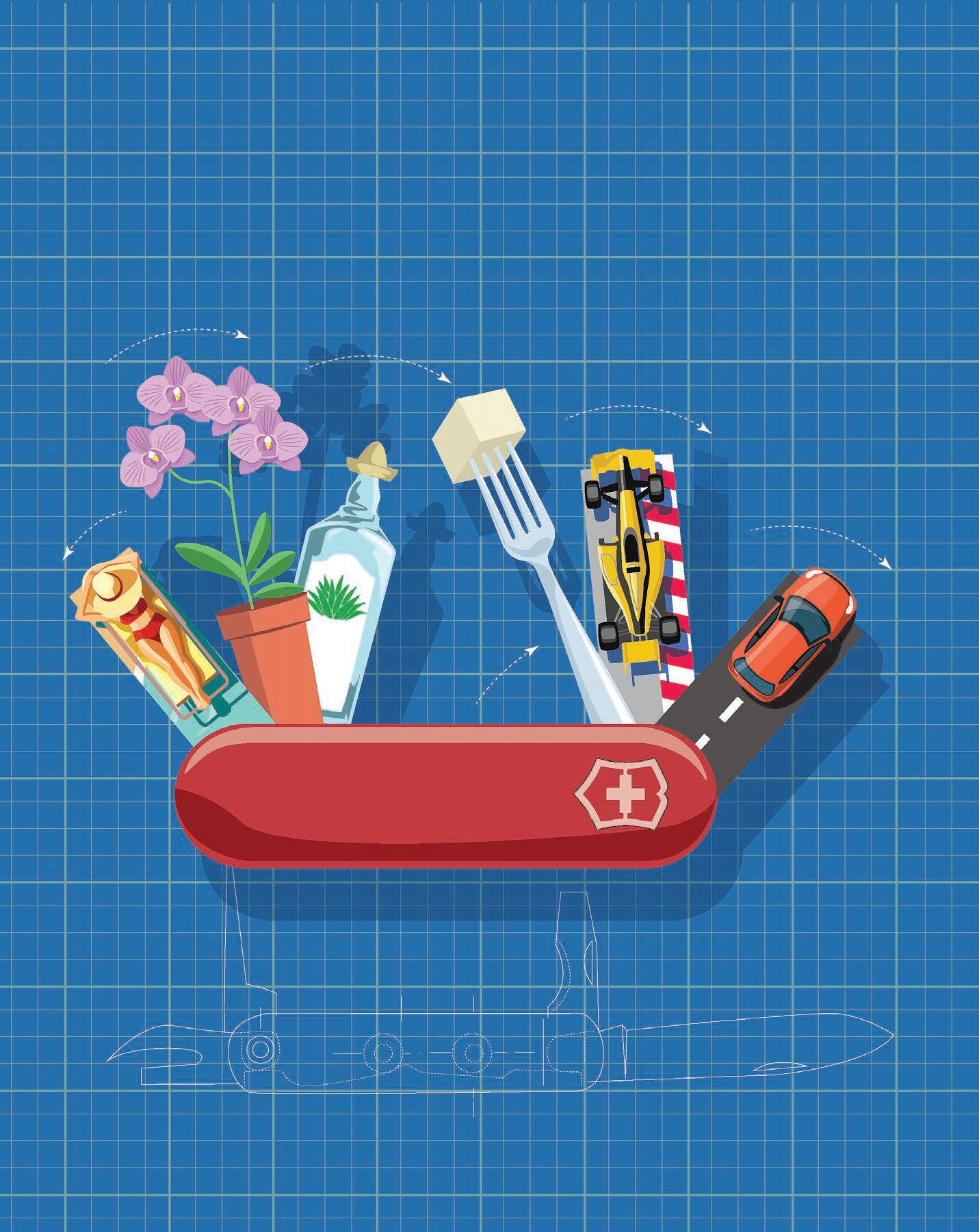

How to do
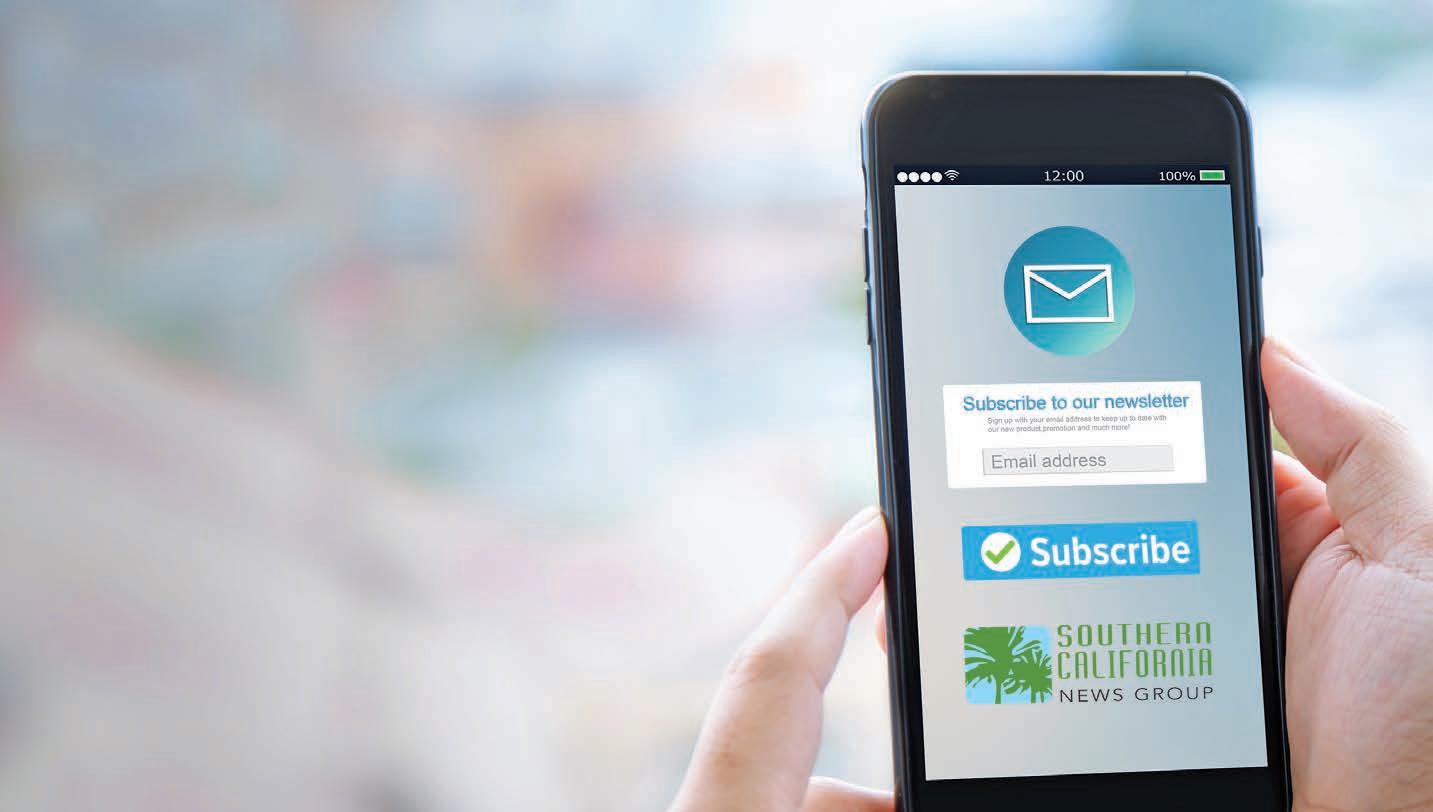




Travel solo
Tips for making the most out of trips when you're going it alone page 13

Drink tequila
Here are the best ways to enjoy this Mexican liquor like a gourmet page 24
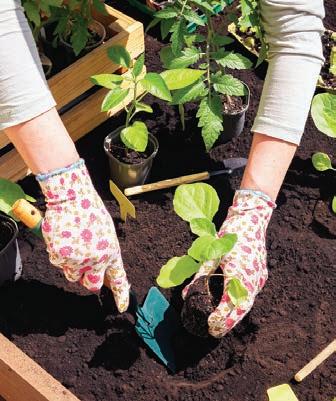
Dig in the dirt
Getting your hands in the earth might be the way to wellness page 40
PRESIDENT/PUBLISHER
RON HASSE publisher@scng.com
EXECUTIVE EDITOR
FRANK PINE fpine@medianewsgroup.com
SENIOR VICE PRESIDENT, ADVERTISING
KYLA RODRIGUEZ advertising@scng.com
SENIOR DIRECTOR OF MARKETING
CAROLINE WONG cawong@scng.com
editorial EDITOR
SAMANTHA DUNN sdunn@scng.com
PHOTO EDITOR
MICHELE CARDON
COPY EDITOR
JERRY RICE
COPYRIGHT ©

CONTRIBUTORS
DANIELLE BAUTER, JIMMY CAMP, JEFF GRITCHEN, KIM GUIMARIN, TODD HARMONSON, ANDRE MOUCHARD, JENNY PETERS, KAITYLN SCHALLHORN, TONI SCIACQUA, A.K. WHITNEY
CREATIVE DIRECTOR
LAILA DERAKHSHANIAN cover ILLUSTRATION
JEFF GOERTZEN
Real advice from real people
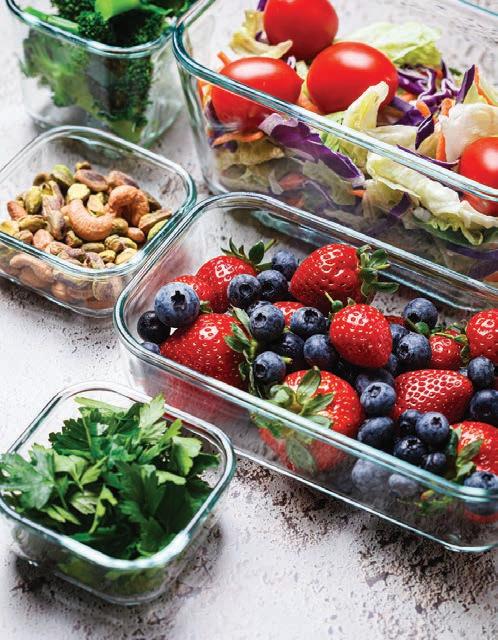

DEAR SUBSCRIBERS,
In an era where we rely on online reviews and shy away from anything under four stars, there’s something to be said for firsthand knowledge and trusted experience. New perspectives gleaned from personal observations, useful insights on different approaches to common problems specific to Southern California, ways to make life that much richer — like friends talking over the proverbial backyard fence.
That’s the idea behind this “how to” issue, a theme for summer that we began last year. Samantha Dunn, our PREMIUM magazine’s editor, assembles an eclectic mix of engaging articles that aim to offer useful advice on living well, all mined from the perspectives and wisdom of a wide range of writers from our own staff and a few longtime contributors.
Take, for example, the moving — and helpful — takeaways on honoring a loved one shared by senior editor Todd Harmonson, who has, unfortunately, developed an expertise for writing eulogies, having prematurely lost too many beloveds.
Another of our editors, Toni Sciacqua, shares her experience on making the switch to a plantbased diet for her health, and offers tips and tricks for making vegetables interesting — yes, it’s possible — that she’s learned along the way.
Editor Kim Guimarin has spent literally thousands of hours commuting in Southern California traffic and is armed with all the road warrior moves, which she shares with us. Another one of our senior editors, Andre Mouchard, shares his experience on trying to get his kids to love the same movies he loves, to greater and lesser

success with each child. But what really matters, as you’ll see, is the connection he enjoys with each.
This issue is filled with the kind of random information you didn’t know you wanted to know until you see it. What were the ways our caveman ancestors fell asleep when they had to worry about saber-toothed tigers? What is gained when people speak kindly to each other? What is the deal with Formula One racing and why do people enjoy it?
That kind of sharing of information, human to human, is something I hope never goes away. And we would love to have you join the conversation. What life hacks do you have that could be useful to others? What would you like to share? Write to our editor at sdunn@scng.com and maybe we’ll use your insider knowledge in a future story featuring tips and tricks from readers just like you.
Delivering the best in local news is an important endeavor, one we are proud to carry on. Thank you for supporting journalism that cares about the community.

How (and why) to talk nice
Workplace consultant and author Minda Harts wants us to speak to each other in a way that builds trust
BY SAMANTHA DUNN
In 1992, a Baptist pastor named Gary Chapman published a book titled “The 5 Love Languages,” about how to categorize different ways we express and receive love. You might know or have heard of Chapman’s theory of the five languages, because they’ve become a kind of cultural touchstone in the subsequent years since the book came out: words of affirmation, acts of service, receiving gifts, quality time, and physical touch. Chapman’s theory goes that if we can communicate in each other’s languages, we can strengthen our relationships and find fulfillment.
Now, Beverly Hillsbased workplace consultant and author Minda Harts has an updated and timely spin on this old idea.
In “Talk to Me Nice: The Seven Trust Languages for a Better Workplace,” Harts lays
out how a lack of trust among colleagues, managers and executive leaders is not only bad for business and professional development, but also bad for our emotional well-being. How to build trust among people? That’s where Hart’s own theory of seven workplace trust languages comes into play. She says that just like falling — and staying — in love, earning trust is different for everyone. By understanding the seven languages of trust — transparency, security, demonstration, feedback, acknowledgment, sensitivity, and followthrough — people can start to better navigate conflict, be more productive and communicate more effectively. What’s more, she asserts that by understanding one another’s languages, we build an environment of trust that in turn creates
a more equitable, sustainable and profitable workplace that benefits everyone.
Harts has worked with corporations like Nike, Google, Best Buy and JPMorgan Chase to redefine leadership and workplace culture. LinkedIn has recognized her as the #1 Top Voice in the Workplace and by Business Insider as one of the top 100 People Transforming Business. Her previous books include “The Memo,” “Right Within” and “You Are More Than Magic.”
“‘Talk to Me Nice’ isn’t just a book; it’s a conversation we all need to have,” Harts told me in a recent email exchange. “Work doesn’t have to be a place of tension. When we learn to speak each other’s trust languages, we create space for people to feel seen, safe and heard. That’s the future of work, and the future of community, too.”
Q: When did you know you had to write “Talk to Me Nice”?
A: I think I realized the moment that workplace problems weren’t just about productivity or performance, but about broken trust. I kept hearing people say, “It’s not what was said, it’s how it was said.” That stuck with me. So much of the stress we feel at work and, honestly, in life, comes down to how we’re communicating, or not communicating at all. I wanted to offer a new way forward.
It feels to me like social media and public discourse in general have become ruder, and that influences our communication styles. Do you think that’s true?
Yes, absolutely. The way we speak to each other online has bled into how we speak to each other everywhere. There’s a performative edge now — people talk at each other instead of with each other. We’ve gotten so used to reacting quickly that we’ve lost patience, nuance and empathy. And that spills over into our workplaces, our friendships, our families.
What do we lose when we don’t communicate nicely with each other?
We lose trust. We lose connection. And we miss out on real collaboration. “Nice” isn’t about being soft! It’s about being intentional and respectful. When that’s missing, people shut down. They hold back. They don’t feel safe to be honest, and everything suffers: team morale, creativity, even performance. It’s not just a vibe shift; it’s a business issue.
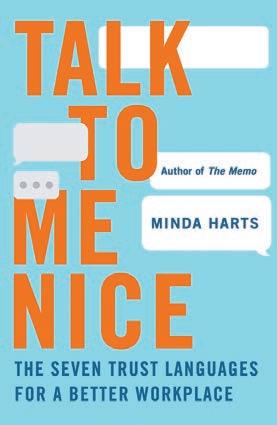
In your new book, you write about the seven workplace trust languages: Sensitivity, transparency, security, demonstration, feedback, acknowledgment, and followthrough. You put sensitivity first. What does that mean to you?
Sensitivity is really about being emotionally aware. It’s the opposite of walking into a room and ignoring the temperature. It means paying attention to how your words land, being mindful of their impact. You can have the best intentions in the world, but if your delivery shuts someone down or dismisses their experience, it creates distance. Sensitivity builds a bridge; it says, I see you. I respect you enough to think and act before I speak.
You say the old ways of communicating are no longer working for everyone. Can you talk more about that?
For so long, communication at work was built around hierarchy and power. One person talks, everyone else listens. Or worse, people pretend to, but don’t feel safe
enough to say what they think. That doesn’t work anymore. People want transparency, not top-down directives. They want to be acknowledged, not just for assignments. We’re in a new era, and if we don’t evolve our communication methods, we’ll lose talent, trust and momentum.
Trust, and restoring it, is the central theme of your new book. You are aiming at business professionals, but it seems like a lot of these concepts translate to many aspects of current life… Yes! We apply trust to our romantic and platonic relationships, but we rarely apply relationship skills at work. Studies show that we will spend 90,000 hours of our lives at work, and building and maintaining trust should matter there too. The seven trust languages are rooted in human behavior. They’re about listening, following through, and creating a safe environment. Whether it’s your team, your partner or your teenager, it all comes down to how we show up in our communication. Trust is the thread that runs through everything.
If people make only one change in how they communicate, what would you suggest it to be? Pause before you respond. That one small moment can change everything. It gives you time to consider tone, intention and impact. In that pause, you can choose trust over ego. It’s simple, but powerful.

Tips from the Stone Age for better sleep
WPHOTO BY GETTY IMAGES
e spend roughly a third of our lives in bed. But back when our ancestors evolved hundreds of thousands of years ago, saber-toothed cats were their biggest nighttime worry, and wakefulness served to protect one’s tribe at night. They had no concept of sleep stress; in fact, their episodic sleep patterns gave them an evolutionary advantage. Yet, while the factors keeping us up at night might have changed since early humans snoozed in their caves, the solutions haven’t. As sleep scientist, psychologist and recovering insomniac Dr. Merijn van de Laar argues in “How to Sleep Like a Caveman,” we modern
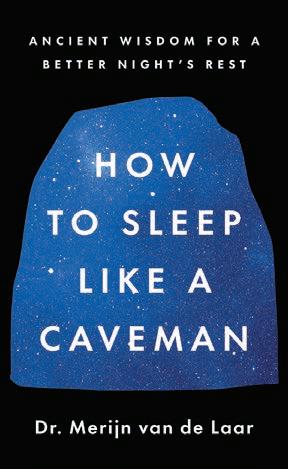
humans should look to their example to improve our own sleep health — and make peace with our own uniquely personal sleep habits.
The doctor contends that while humans have evolved from the prehistoric period that began 3-5 million years ago and ended at roughly 3300 BCE, ancient habits are still within us. He points to one example that could be a relic of our early ancestors that we’ve never outgrown:
You know the feeling of nodding off, only to be suddenly jolted awake by the sensation that you are falling from a great height? Scientists call those muscle contractions “hypnic jerks.” Why does this phenomenon occur? It was probably important for survival, says van de Laar, because early humans likely slept in trees to keep safe from predators who roamed at night. So, he says, “if you are a tree-nesting inhabitant who falls asleep in an unfavorable place at a high altitude, you could easily drop out of a jungle tree as your body’s muscles contract for a moment, you are startled awake and are able to check that you are
in a safe place.”
He notes that when primitive man started using fire, “it became less necessary to spend our nights in trees as lighting campfires at night kept predators at bay. There was a significant advantage to sleeping on the ground.
Primal man got a more stable night’s rest than in the dangerous heights, which probably led to deeper and less interrupted slumber. That improvement had a positive effect on the brain in general. Our current cognitive intelligence might even be the result of the transition from tree sleep to ground sleep.”
Fun fact: The earliest bed that has been discovered
dates from around 200,000 years. (Forget cotton percale sheets; our ancestors used branches, grass and leaves!)
Drawing from emerging science as well as archeological research into our ancestors’ sleep habits and close observation of contemporary huntergatherer cultures, van de Laar’s book explains why our efforts to optimize our sleep schedules according to the demands of modern life might just be a fool’s errand.
“How to Sleep Like a Caveman” offers up a 12-point plan to get a better night’s sleep in three weeks, which includes:
• Use a sleep diary to record your sleep patterns. This will give you an idea of how you
think you are sleeping and allow you to compare it to how you feel.
• Examine your attitude toward lying awake at night, and realize that it’s actually normal for us to lie awake at night — it’s only a problem if you’re anxious or restless.
• Focus on the quality of your sleep, not the quantity.
• Keep regular sleep times. “The basis of our sleep is a strong circadian rhythm,” van de Laar writes. “Varying times at which you go to sleep is not supportive.”
• The ideal amount of sleep isn’t eight hours for everyone. In fact, the ideal amount is highly personal, “much like your shoe size.”
–Staff report

PHOTO COURTESY OF MARINER BOOKS, HARPERCOLLINS
Dr. Merijn van de Laar
5 steps for grieving the orchid you will kill
BY A.K. WHITNEY
Recently I invited a friend over for high tea. But when I opened the front door to greet her, she was holding a gorgeous moth orchid, its arc of waxy white blooms balancing gracefully on a long stake.
My heart sank.
It was no doubt meant as a thoughtful hostess gift, but, Dear Reader, I have never met an orchid I cannot kill.
I didn’t want to hurt my friend’s feelings by refusing it, or try to regift it to another person with orchicidal tendencies, so I resigned myself, once again, to going through the five stages of orchidmurdering grief.
Denial

This time will be different, I tell myself as I stare (resentfully) at my newest floral occupant. I read the smug comments on an orchid subReddit boasting about their plants’ superior longevity, because they would never over-water them. I read an even more smug article in Better Homes & Gardens. Finally, I message my never-smug friend who is famed for her beautiful flower garden.
“My brother gives his indoor orchids one ice cube a week,” she writes back. “But any outdoor orchids, I have killed.”
Uh oh.
Anger
A few weeks of ice cubes later, the perfect blooms are no longer perfect. It could be the result of a recent heat wave, but the orchid is probably making me feel guilty for daring to take a vacation.
As I roll my shopping cart into the neighborhood Trader Joe’s, ready to stock up after said vacation, a lush, and very reasonably priced display of orchids greets me. Suddenly, I am furious. Orchids were once considered exotic luxury items for the moneyed elite. Men

PHOTOS BY GETTY IMAGES

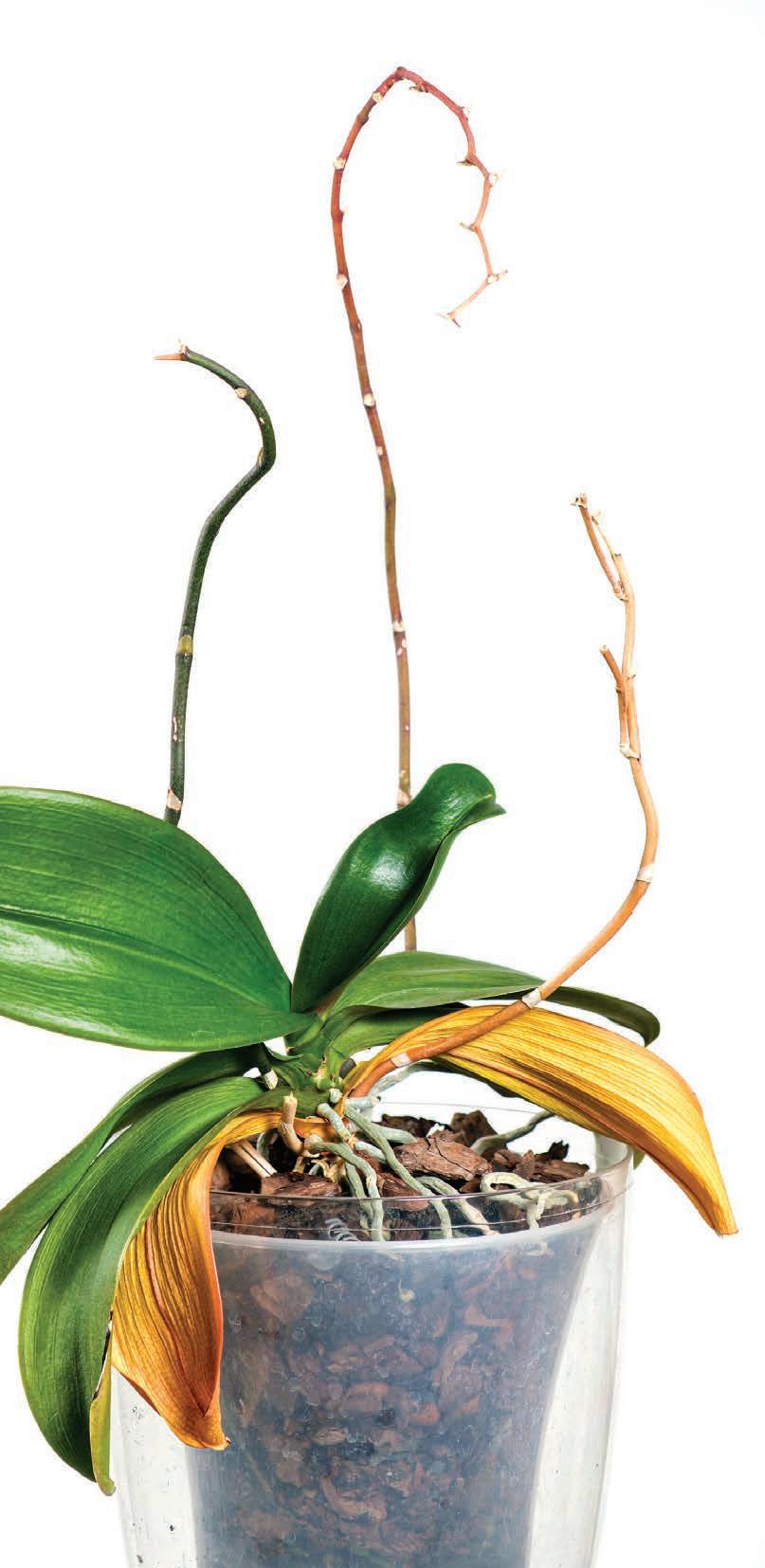
in pith helmets and handlebar moustaches risked their lives in jungles to bring the most beautiful specimens they could find back to the likes of Arabella Huntington. To this day, the Huntington Library in San Marino has one of the largest orchid collections in the country. What would Arabella say about the fact that for a few paltry bucks any fool can now buy, and then neglect and disrespect, her most treasured flora?
But that’s when I come up with the perfect solution: Set aside a few hundred dollars and buy Trader Joe’s entire stock of orchids! It’s the perfect solution for saving future orchids from slaughter. No more orchids for sale, no more future dead orchids.
I can say the same for artichoke tortellini, English muffin bread, and canelés. Which is to say, every time I find a product there I really like, they discontinue it almost immediately.
Bargaining
Most of the orchid’s stem is now bare. Just one withered blossom clings to the end, so I decide to end it. But before stuffing it into the green bin, hopefully out of sight of judgy neighbors, I tell my husband what I am doing. He is prone to pulling things out of the trash and asking if I really meant to throw them away.
“It’s not dead yet!” he protests as anticipated, then pulls out a canister of orchid fertilizer and another of orchid growth hormone.
Where on earth had he been keeping those in our tiny cottage? The last time he killed an orchid was in 2021. Clearly, I am not the only one in the household going through the stages of orchid grief.
Sadness
The last bloom is gone. Now I have to decide whether to trim the stalk and then wait to see whether anything regrows. I know it won’t, because my living room is nothing like the Florida Everglades, which boasts the most orchids of anywhere in the country. But this may be a good thing, since I don’t think I could cope with the humidity, or worry about a super snake or alligator devouring me on my way to the sofa.
Still, the sadness persists. With more than 28,000 orchid varieties in the world, I can’t keep one specimen alive? In contrast, there are only 4,600 types of cockroaches. Maybe we should cross them with the orchids? That way, these “orchroaches” would be guaranteed to survive Armageddon. And maybe even my care.
Acceptance
After staring at the long bare stem for a few weeks, I can’t stand it anymore. I have to face the fact that I’m a serial orchid killer.
But I cut it to the first node below the last flower, as recommended by Better Homes & Gardens. Then I deliver it to my husband. After all, he’s still stuck in Denial.
How to enjoy traveling alone
Follow this advice and you may never want a travel partner again
BY JENNY PETERS

Bitten by the travel bug but can’t find one single person willing to travel by your side? Or maybe you need to truly get away all by yourself? If so, you’re part of the ever-expanding global group known as solo travelers, people who in recent years have decided not to wait for anyone else to join in their adventures.
PHOTO BY GETTY IMAGES
‘
Traveling solo doesn’t mean moving in isolation, for with so many others doing the same thing in all corners of the world, making a new friend along the way is a definite perk of not being part of a pair or a bigger pack. And that, too, is up to you.’
This burgeoning trend seems to be a partial offshoot of the pandemic lockdown, which forced people to go it alone at home. Some discovered they actually were content being on their own, and once the world opened up again, they were ready to travel solo. Others had begun to take me-only trips even before those tough times, a fact that was already making travel companies like hotels, cruise lines, tour operators and even restaurants rethink their policies toward accommodating a single person traveling alone.
So, whether you’re one of the women of all ages deciding to head out and see the world on your own, or perhaps one of the millennial or Gen Z males who are also making up a large chunk of solo travelers, here’s our how-to guide with ways to make traveling by yourself a nostress experience.
Plan it out
Being a solo traveler means you make every decision, from where to go to how to get there, where to sleep, what to see, do, eat and drink. Everything. And part of the appeal of going it alone is doing the planning yourself — with the help of search engines, of course. Obvious choices come first: How are you getting there? Are you flying, roadtripping, training, cruising or a combination of those things? Plan out each leg of travel.
Keep in mind that booking directly with the key services you’ll be using
(airlines, cruise lines and hotels, particularly) is always the smartest way to travel, solo or otherwise.
That’s because if and when things change, on your side or theirs, you have a direct way to contact the company rather than going through a third party, which can be fraught with delays, problems with reimbursement and more.
This plan is especially wise when it comes to booking flights, particularly on trips that have connections. That’s because the airline you book with is handling your full itinerary (even if using partner airlines for some flights); they’ll be responsible for making sure you and your checked luggage actually reach your desired destination.
Trains in most places in the world do not offer that sort of connection help, so be certain to book your travel legs with enough time to change trains, so you don’t watch your connecting train pull out as you arrive on the correct platform. Cruise-ship companies often offer airline travel (and transfers) as part of their bookings, which also means they will be proactive in getting you to the ship before it sails.
And while home stays, via Airbnb, Vrbo, etc., might seem cost-effective as opposed to traditional hotels, booking a hotel usually makes the most sense for solo travelers. Think better safety and security, ease of early or late check-in, central locations and no exorbitant cleaning fees charged (often after
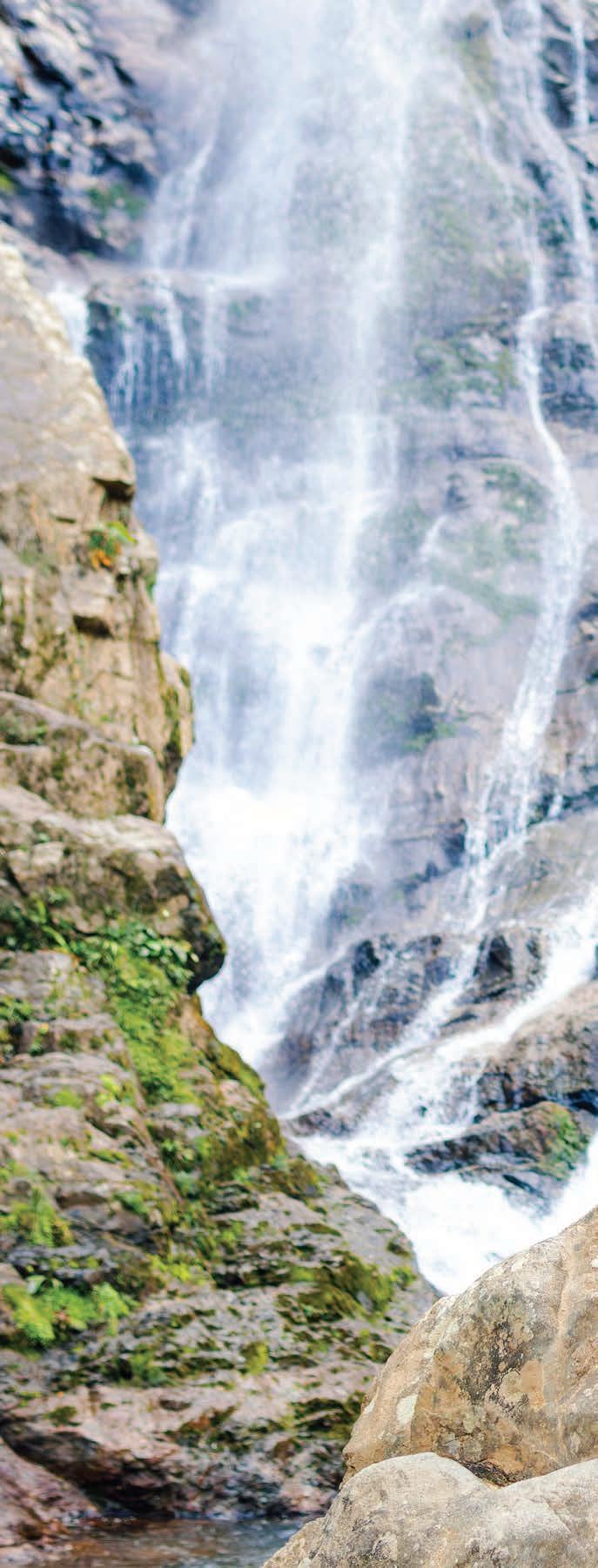
PHOTO BY
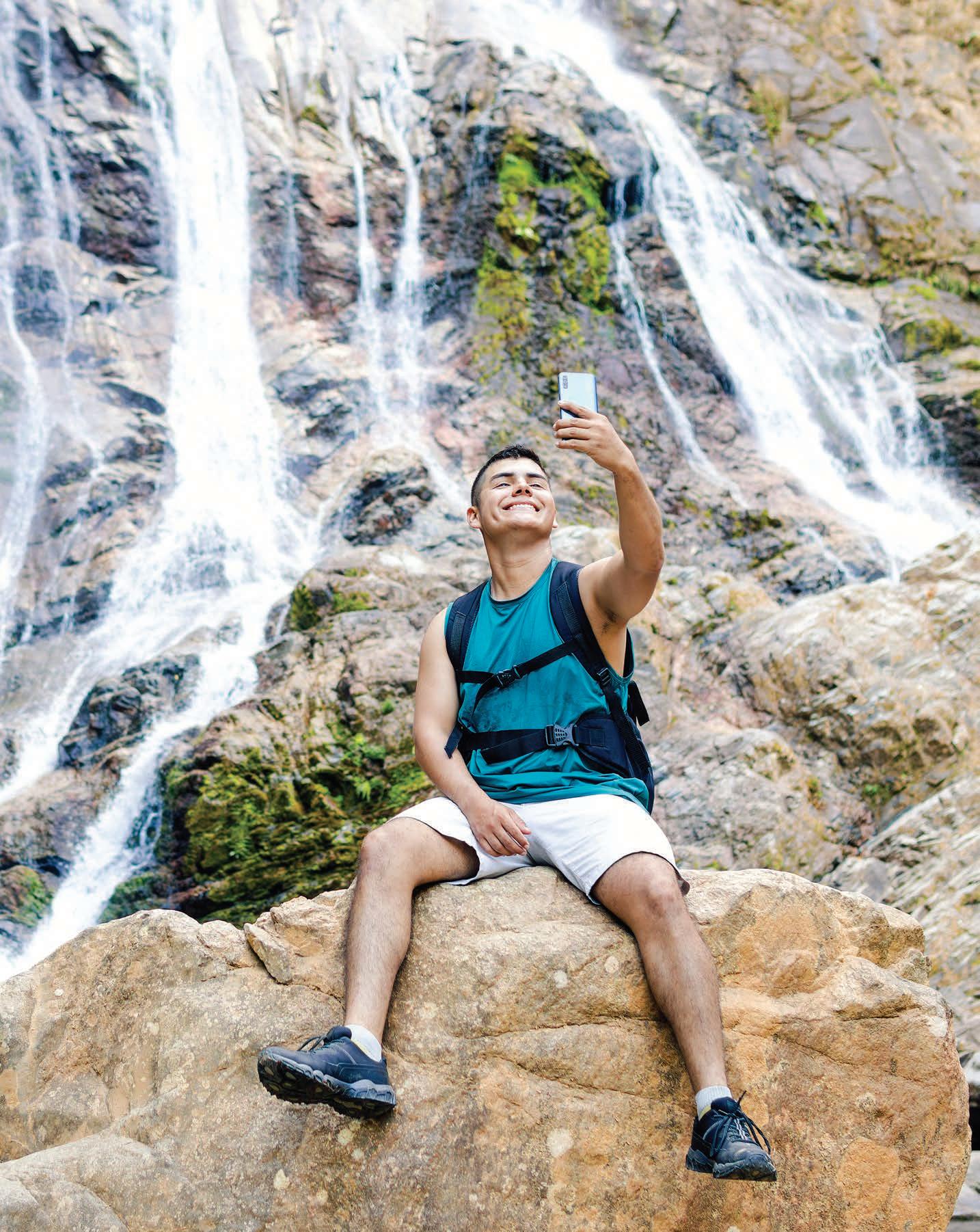
you have cleaned the place yourself). Even the lessexpensive option of staying in hostels means you don’t clean your own room — although you may be sharing it and the bathroom with strangers.
No matter how you travel, book travel insurance with a reputable company, including Allianz or World Nomads. The most costeffective way is to take out
a yearly policy (rather than on a per-trip basis), which usually covers key things like flight cancellations, lost luggage, emergency medical expenses and more.
If the idea of doing everything yourself seems too overwhelming, using a reputable travel agent to help is certainly an option, but remember that an agent adds another layer between you and the actual provider.
Be smart – and safe
Being safe while traveling alone, especially for women, is actually just an extrapolation of what you do every day in your life. Hang onto money, passport, drivers license, cellphones and other valuables — especially on crowded city streets, but also at places like the beach, the bar, the theme park, the sports stadium and even
the museum. This means don’t put the things you’d hate to lose in a back pants pocket or easily opened backpack compartment; use crossbody purses/ bags with interior zippered compartments for those valuables, wear a money belt or at least use your front pockets to make things tougher for pickpockets. Lanyards for cellphones

deter thieves, especially those on motorbikes or bicycles who grab it and go; plus, they stop you from putting your phone down and inadvertently walking away without it.
RFID-protected wallets and handbags stop more sophisticated criminals from skimming your information electronically; paying via apps on your cellphone reduces the times you reach
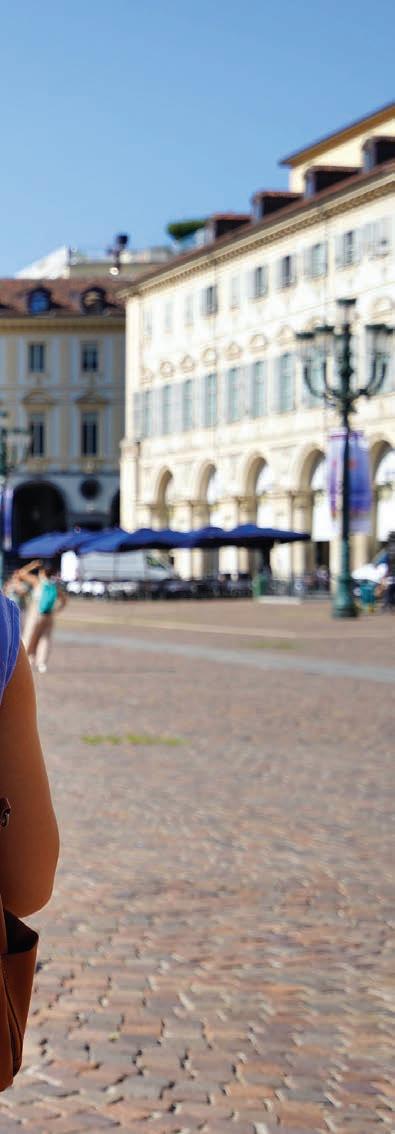
for your wallet. Also be aware that open/unsecured wifi networks mean hackers can steal the information you input, too.
And, like back home, listen to your instincts. If a place or perhaps an offer someone is making to you seems a bit shady or too good to be true, it probably is.
To tour or not to tour
Knowing where you want to go, how you will get there and how to travel safely brings the solo traveler to the next question: Do you want to be truly alone for your whole trip, with no commitments at all? Or, maybe you want to be alone with others? Either way of solo traveling works, and you can create a combination of both as well.
Booking a solo fullvacation tour or a cruise-ship experience used to be a moreexpensive proposition, as those companies used to overcharge “solo supplements” that penalized travelers for going it alone — but that is changing in favor of the lone traveler. According to the 2025 Hilton Hotels Trends Report, nearly 50 percent of their global guests travel alone, with 44 percent looking for activities that offer a chance to meet others doing the same, which adds up to a lot of people heading off alone.
That’s the reason you’ll find top cruise companies with no single supplement fees, including Virgin Voyages, Oceania Cruises, MSC Cruises, AmaWaterways, Holland America and others (like Norwegian Cruise Line, which pioneered the concept of solo staterooms built just for singles). With so many possibilities of boarding a ship without paying a penalty for being alone, the solo cruise traveler’s motto should be “I never pay
a solo supplement.”
Joining a full-vacation tour also has changed, as many companies around the world are focusing on the single traveler. Solo Female Travelers Tours is designed by females for females of all ages to see the world in groups of solos, while Road Scholar leans into senior travelers who love “learning adventures” across the globe, with some of their group trips created solely for those signing up alone, and all trips open to solos. Just remember that when booking a non-solo tour group, you just might end up on a trip full of couples and only you solo, which may not be an ideal scenario for you.
Inntravel takes an approach that’s perfect for the adventurous solo traveler, offering hyperlocal self-guided tours across many UK/European countries that feature walking, cycling or traintravel tours, all with hotels, daily routes, sightseeing and complete itineraries planned out for you to do it alone every step of the way, no matter your sex, fitness level or age group.
One of the beautiful things about traveling by yourself is there’s no need to make plans way ahead of time, as making bookings for one isn’t very complicated, especially with the numerous reputable companies offering local tours in many places. Get Your Guide matches travelers with experienced guides that speak your language, know the inside scoop on your destination and can show you anything from the top attractions to the coolest food tours and beyond, while ExperienceFirst specializes in fascinating daily walking tours in American cities as well as selected European destinations, letting you see everything from a San Francisco True Crime Tour of the Haight to Barcelona’s
Best Food Markets.
GoCity really lets you go it on your own, with a sightseeing-attractions pass that covers one of more than 25 cities, ranging from San Francisco to Singapore, Dubai to Dublin. In each city, pick your favorite kind of pass for discounted admissions for numerous top attractions (think museums, theme parks, hop-on, hop-off buses) as well as walking tours, pub crawls and more.
And Daytrip is a seamless, safe, award-winning transfer service offered in 130-plus countries that solves getting from place to place easily and safely, via private driver. Think Lisbon to the Algarve, where destinations are often far from public transport centers, or even Los Angeles to Las Vegas — Daytrip drivers will go the distance you desire and even stop to allow you a planned sightseeing visit as you travel.
Make new friends. Or don’t.
Traveling solo doesn’t mean moving in isolation, for with so many others doing the same thing in all corners of the world, making a new friend along the way is a definite perk of not being part of a pair or a bigger pack. And that, too, is up to you. So, if reading a good book or playing a favorite word game is your choice of traveling companion or dinner partner, then that’s your solo style.
Never feel compelled to engage, while at the same time be open to what the world you’re discovering is offering up; and if you’re feeling a bit lonely, go ahead and be the one to start the conversation. Your solo trip is all about you. That’s the beauty of it.
How to travel as an American in challenging times
Global conflicts. Shifting political alliances.
Here’s what to do if you simply want to enjoy a vacation in another country.
BY JENNY PETERS
Recently I was enjoying an excellent, locally owned Scranchester Tours walking history tour of Manchester, England, with a Canadian woman from Montreal I had just encountered. Then she told me, “Canadians have always been America’s allies, but not anymore. We honestly don’t want to have anything to do with any of you.”
She was not kidding, just being brutally honest — harsh words from someone I had just met.
It was a sentiment I had never heard before in all my years of traveling the globe as a proud American and professional travel writer; it gave me pause.
It’s a brave new world out there beyond the borders of the United States in 2025. As a seasoned travel journalist who has visited 70 countries and been covering the travel beat for more than 25 years, the change in the world’s perceptions of America is obvious, thus forcing me and any other globetrotting American to ask the question: How do I travel internationally as an American in a world of shifting alliances and conflict?
Truth be told, the stereotype of “The Ugly American” has been around since authors William Lederer and Eugene Burdick’s bestselling political novel of the
same name was released in 1958, then reinforced by the 1963 film of the same name starring Marlon Brando. Depicting Americans as arrogant, loud, boorish and demeaning of other cultures, the term has stuck and is still mentioned 60-plus years later.
So, for starters, as you grab your passport and head onto the plane, cruise ship, behind the wheel of your car for a cross-borders road trip, be determined not to become the ugly American as you travel.
The ways to do this are actually simple, but they require you to open your mind to a key fact: The rest of the world is very different from the United States, and the way other cultures live is to be respected.
Plan ahead
Doing some research about the country you are visiting before departing helps you understand some basic cultural points. Check the currency accepted where you are headed, look at the exchange rate (how much a U.S. dollar is worth against the country’s local currency) by using the Xe currency convertor app for an idea of what your money will be worth on the trip, and plan to get some local cash from an ATM upon arrival unless you’re able to take care of it through your bank at home.

PHOTO BY GETTY IMAGES
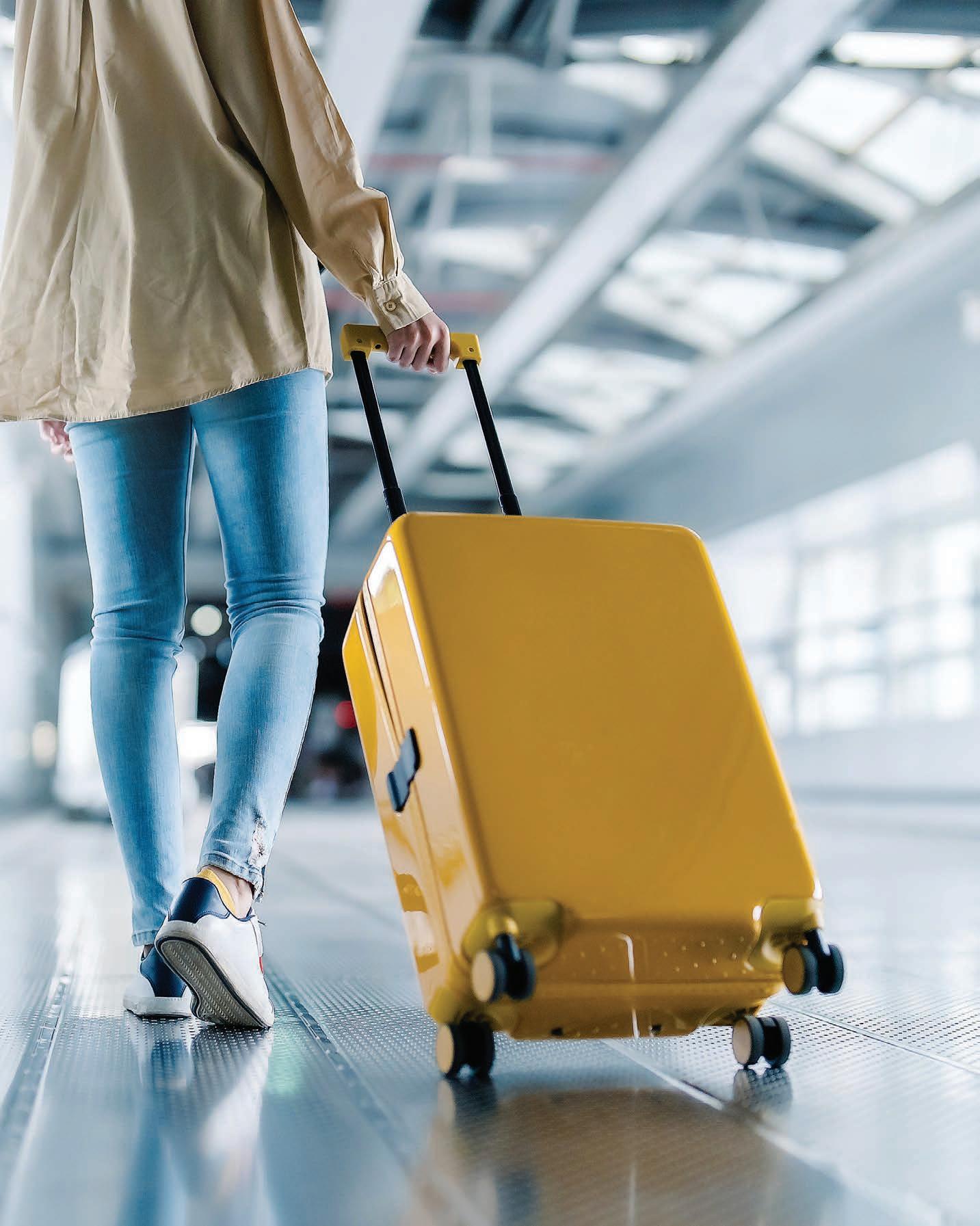
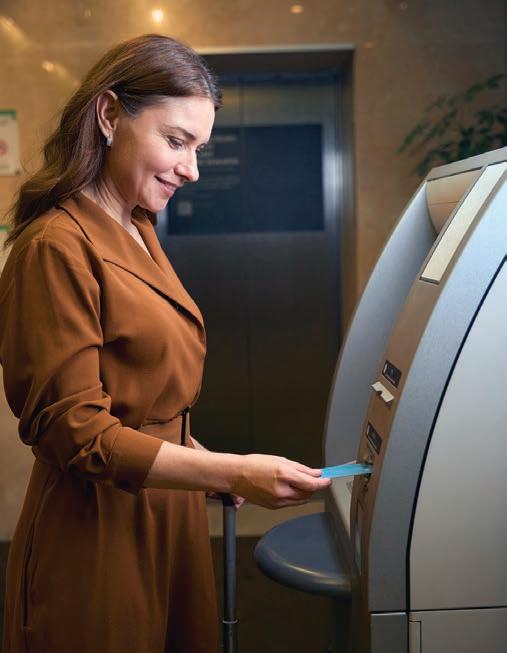
Be aware that it is more costeffective to get cash from an ATM than changing dollars at a local bank or currency broker; and know to always choose the local currency price when using a credit card to pay, not the U.S. dollars price. You will always get a better exchange rate from the card company when they complete the transaction in the local currency. Having cash is still necessary in many countries for taxis, tipping, and at street markets, bazaars and other small businesses. And know that trying to give someone USD is usually not acceptable, as they often cannot change the currency.
Americans are used to tipping, but it is not the norm in most other countries, so research what is expected before you go. Many other countries pay waiters, hotel staff and other service workers good wages, so tipping is not part of the culture. Cruises and organized tours usually indicate if tipping is expected (or included in the price).
Americans often assume that English is spoken everywhere, which is not true. So being polite and at least trying to learn some basic phrases in the language spoken is a beginning, like how to say “hello,” “thank you” and “good morning.” The Google Translate app is very helpful for conversation that goes beyond basic phrases, so it’s helpful if you have connectivity with your phone while traveling. And always ask if the person you encounter speaks English; never assume it.
Respect the place and its people
Visiting other countries is an adventure, but some Americans seem to expect everywhere to be just like home. The reality is, most places are nothing like the United States, especially when it comes to cultural norms, language, religions and laws. Sometimes those differences are easy to see, like driving on the opposite side of the road, while others, such as expecting the police and judicial system to work like it does here, are much more complicated and lead Americans to make wrong assumptions.
For example, bringing chewing gum into Singapore is illegal, as is chewing the gum; the same is true for nicotine vapes. China does not guarantee due process if you are accused of a crime, and Saudi Arabia can arrest and detain visitors without a trial. In other words, knowing something about the country you visit is key to understanding what the traditional rules and current laws are.
The U.S. government gives information about visa requirements and other valuable advice for citizens traveling to other countries at usa.gov/ visas-citizens-traveling-abroad and sets travel advisories at usa.gov/traveladvisory, so be advised to check before you travel.
For instance, a visit to the United Kingdom now requires an application — and payment of a little less than $22 — through its electronic travel authorization system. It’s quick and easy if you do it ahead of time. Similar systems are scheduled to be put in place for the European Union, starting late in 2025 and expanding in late 2026.
Respect for religious differences is fundamental, especially when visiting a place that is predominantly Catholic, Muslim, Hindu, Jewish, etc., because there are specific ways you are expected to behave in those places. Think scarf head coverings for women in Catholic churches, shoe removal for all to enter a mosque, yarmulkes required for men in synagogues, but also pay attention to the cultural norms away from houses of worship and behave accordingly to avoid being considered a rude American.
Many countries are not as casual about clothing as the U.S., so follow their traditional customs out of respect for their culture. Let’s say you’re heading to the Red Sea International Film Festival in Jeddah, Saudi Arabia,
Know before you go: Laws and cultural norms in other countries, such as Singapore, are vastly different from the U.S.

in December. If you are female, showing skin is not acceptable there, so plan to cover your legs, shoulders, arms and (especially) your décolletage, despite the heat. Male? Wearing female clothes or makeup there can get you arrested.
When visiting Uganda, perhaps on a journey to see the Silverback gorillas, women are expected to cover their legs, at least to below the knees. And wearing pants is not the custom in the country; it’s skirts only. Going to the tropical paradise of the Maldives? That is a very conservative Muslim country. So, on the capital (and home of the international airport), Male Island, women are expected to be modest and cover their shoulders, arms and legs. While at island resorts, Western clothing styles are accepted. And remember that in most Muslim countries, alcohol is prohibited, with exceptions made in international hotels or resorts only.
PHOTOS BY GETTY IMAGES
Save money by getting local currency at an ATM.
Get out of your comfort zone
The whole idea of travel is to try new things, meet new people, see sights that you never would have seen, eat foods you’ve never heard of, and get out of the comfortable bubble that we exist in as Americans. Food is a particularly polarizing thing for some Americans abroad, but it doesn’t have to be. Instead of searching for the seemingly omnipresent McDonald’s or Pizza Hut fast food stops that have infiltrated many (too many?) countries, surprise yourself and try the tapas, satay skewers, dumplings, tacos, poi, herring or whatever else the people eat where you’re visiting. You’ll likely find local favorites that relate to the environment around you, traditional comfort foods, newly developed modern delicacies and much more. And there’s certain to be something that reminds you of food you’ve eaten at home, if you are willing to forgo a cheeseburger and fries to discover new things.
Try the local wines, drink the beer that’s been brewed down the road, sip the artisanal mezcal or the gin distilled in someone’s garage, have a sip of cider, a special tea or coffee grown in the area. It’s all part of the experience of being far from home. And if you don’t like something, try a different local taste next. Trust me, your favorite thing is one bite or sip away. Take the plunge; new food is part of being far from home.

Be polite: Use headphones with your devices.
Partake of the local food and drink.
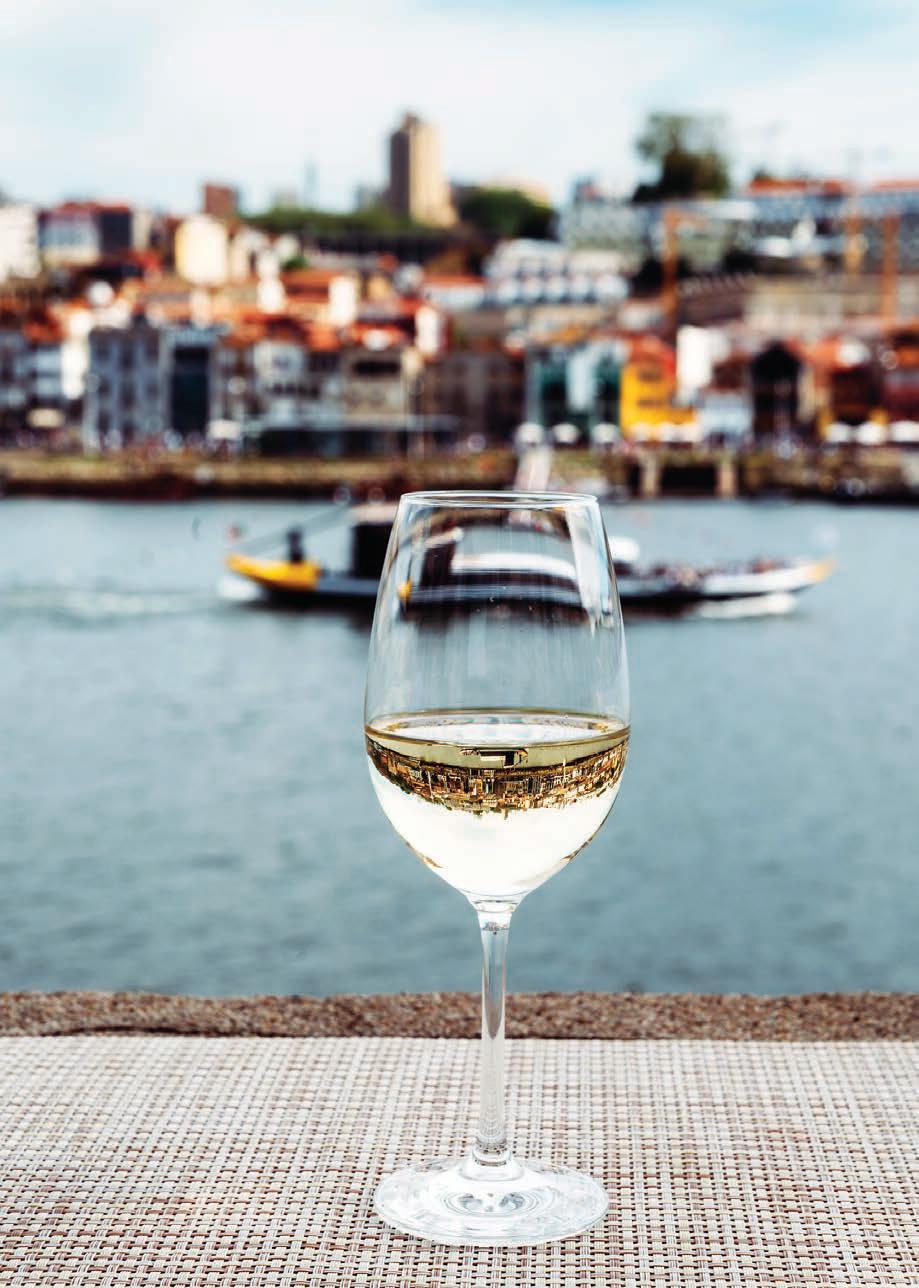
Avoid boorish behavior
People from many different cultures don’t seem to know how to travel, but Americans in particular have a reputation across the globe for being pushy and loud people. I have found it isn’t that difficult to shift the paradigm to be the less-aggro American by simply considering how you (and your family/sports buddies/galpals) are behaving.
The basics: Always use headphones when listening to electronic devices,
speak in low tones when on the telephone or having a conversation in a crowded space, and do not allow your children to run totally out of control. Getting drunk and rowdy, leaving your garbage behind for someone else to deal with, cutting in line, and acting privileged at any point are the hallmarks of that Ugly American (and of some other cultures, too). Acting that way keeps the stereotype alive. Finally, Americans traveling at this time in our history need to
be hyperaware that the shift in American policies in both domestic and international positions have complicated views about our government specifically and often of Americans in general. Being loud about your politics won’t improve your experience while touring most other countries today.
We can and certainly will still travel, but do it with a heightened awareness of the sentiments of those we encounter.
How to give a eulogy
Some
do’s and don’ts for honoring the life of a loved one
BY TODD HARMONSON
No one besides a clergy member wants to be good and, far worse, experienced at delivering eulogies.
I’m both.
Many of us have answered the call to say a nice word or two when someone asks at a funeral if anyone would like to share a memory, but it’s altogether different when it’s your responsibility to deliver a closing argument of sorts for a loved one’s life.
I eulogized my father and brother … on the same day, 10 years ago … at different gatherings.
And I lured the devastated into laughter when my mother died of cancer at only 57 and my great friend never recovered from his massive heart attack at only 48.
I got my start at 20 when I said goodbye to the grandfather who nurtured my love for baseball and Philippe’s French dips, and I’ve had speaking roles of various levels in maybe a dozen funerals or memorials since.
You don’t want to match my bona fides, but maybe some day — hopefully decades from now — you can benefit from my experience and follow these tips when you have to speak on behalf of the assembled bereaved.



Dos & Dont’s
DO Get personal.
Give the mourners some insight about your chosen family member that perhaps only you know but are willing to share with them. You might learn something fascinating from them later in return.
DON’T Make it about you.
As soon as an anecdote relegates your buddy to a supporting role, it’s time to refocus.
DO Go for the laugh.
Your injection of humor into a sad occasion will give everyone permission to react with something other than tears.
DON’T Cross the line.
If you wouldn’t tease Mom about it while she was alive, save the therapy session for later.
DO Write out your eulogy in advance.
You don’t need to stick to the script, but organizing your thoughts and highlighting the points you want to hit will save you when you freeze up. (And print it out rather than read it from your phone.)
DON’T Resort to AI.
So what if your grammar ain’t great? You don’t want some soulless program to tell you what to say about someone who meant enough that you’ll get up to speak.
DO Find a way to calm yourself before you step to the mic. Maybe it’s a breathing exercise. Perhaps it’s a bit of wine. You don’t want to be rattled before you say a word.
DON’T Get hammered to steel your nerves. You might think you’re eloquent when well-lubricated. You also probably think you dance better. Don’t drink so much that you try to prove both.
DO Keep it tight.
Watching the crowd nod off will destroy your confidence.
DON’T Pay attention when someone tries to tell you to limit it to three minutes when you talk about your father. I didn’t.
DO Dress for the occasion. Maybe it’s a suit or a nice dress, but perhaps it’s something in honor of your friend.
DON’T Show up looking like you’ve just been at the beach. Hey, I was covering a beach volleyball tournament in my job as a reporter. I couldn’t help the tan.
DO Cry if you need.
DON’T Worry about what everyone there thinks about your tears. Just know that most will appreciate that you, as their surrogate, were genuine and brave enough to do what they couldn’t.
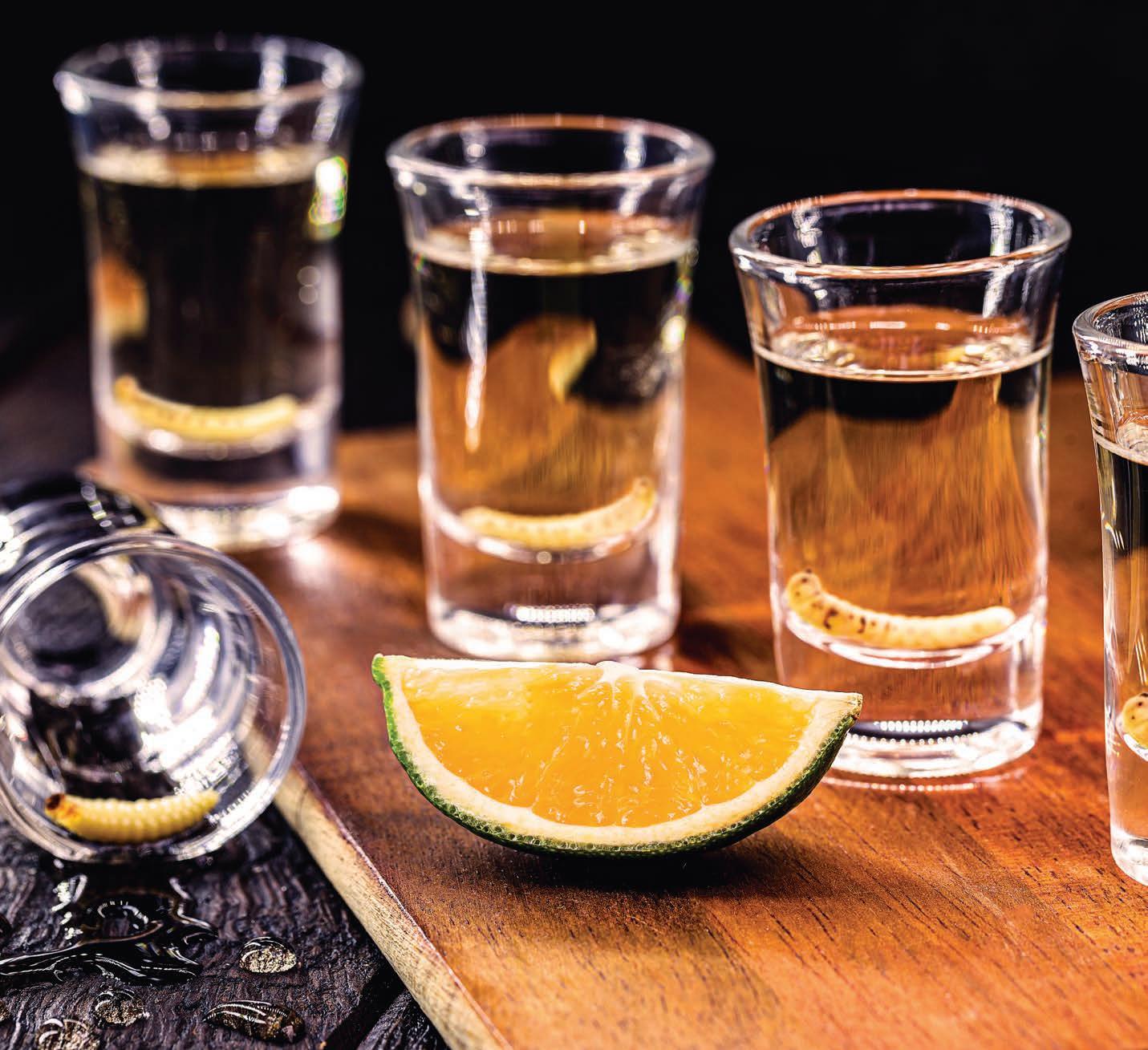
How to stop drinking tequila like an amateur

(You, too, might even become a snob of the agave alcohol)
BY TODD HARMONSON
My younger daughter looked at the tequila in front of her, shook her head and offered her assessment of the latest pour in the Father’s Day tasting my wife had arranged:
“It tastes like college … and regret,” she said.
Laughter and knowing nods followed from the rest of us.
After all, my school daze introduction to tequila came via shots of what should’ve been labeled paint thinner. I slammed it for effect and to avoid the taste.
For many, the relationship with tequila ended in their early 20s with promises made to some dormitory deity — often made of porcelain — to end a miserable night’s agony. And in the ensuing years, only an occasional margarita at a friend’s barbecue or a combo-plate chain rekindled the painful flame in their stomachs.
Many also think Cinco de Mayo commemorates Mexican independence instead of a victory over the French in the 1862 Battle of Puebla, but that’s a subject for a
different lesson.
The fortunate among us, however, graduated from shots to sips and learned that agave plants in the hands of a master tequilero or mezcalero lead to Mexican treasures as unassailable as Fernando Valenzuela’s screwball.
Of course, I turned into a tequila snob in the process. I rarely sip anything younger than an extra añejo, have special glasses and think I know everything because I once read (most of) a book about artisan tequila production.
You can do it, too.
The ascent from amateur tequiladrinker status takes time and perseverance. Dedication and plentiful pours are required to find everything from what you’ll happily mix in a cocktail to the nectar that deserves the right glass, a summer sunset and maybe even a cigar for full appreciation.
You could also follow our tips to expedite the process.

The ascent from amateur tequila-drinker status takes time and perseverance.
LEFT:
PHOTO BY GETTY IMAGES; BOTTOM:
PHOTO BY JOE AMON, THE DENVER POST

Looks aren’t everything
No alcohol comes close to tequila in the competition for attractive bottles, and most bars and home collections feature gorgeous displays that show off color and craftsmanship. You’ll see some of the same choices enough to believe they must be amazing.
Too often, though, the pretty bottle contains a mediocre, mass-produced tequila, yet it packs a price that should be reserved for something special.
Sure, there are exceptions, and several of them have prominent placement on my shelf. But I’m consistently shocked at how much someone will spend on a pedestrian pour simply because it comes out of a good-looking bottle.
If you see something that catches your eye, read reviews and try to get a taste before you plunk down a car payment for swill you’ll regret and wish you could send back. But at least that bottle might make a nice vase.
By the way, apply the same caution to celebrity tequilas. … Actually, apply even more.
Festivals of flavors
Let’s skip past my most recent visit to Baja.
You know, the one that ended with being shaken down near the border, where immediate cash payment of a $200, uh, “fine” miraculously ended a bogus traffic stop and threats that my car would be impounded.
Instead, I choose to remember the trip before that.
Lobster at Puerto Nuevo. Wine and amazing food in Valle de Guadalupe. A gourmet taco crawl. And a visit to the Tijuana Tequila Expo.
For a little less than $10, we gained entry to a tequila festival on Avenida Revolución that came with unlimited samples of Mexico’s favorite creation not named Salma Hayek.
Like Hayek’s cinematic oeuvre, the expo included some regrettable choices, the agave versions of “Wild Wild West.” The least offensive of those went into the large cups we secured to mix with cans of Squirt to make passable palomas; the rest got dumped.
It also featured some award-worthy options that led to purchases to take home. The “Frida” level of offerings included special versions of tequilas I knew and liked but now needed alongside my favorites.
Understandably, a drive south of the border might be too far out of your
A worker known as “jimador” performs the “jima,” which consists of cutting the blue agave, later used to distill and produce tequila.
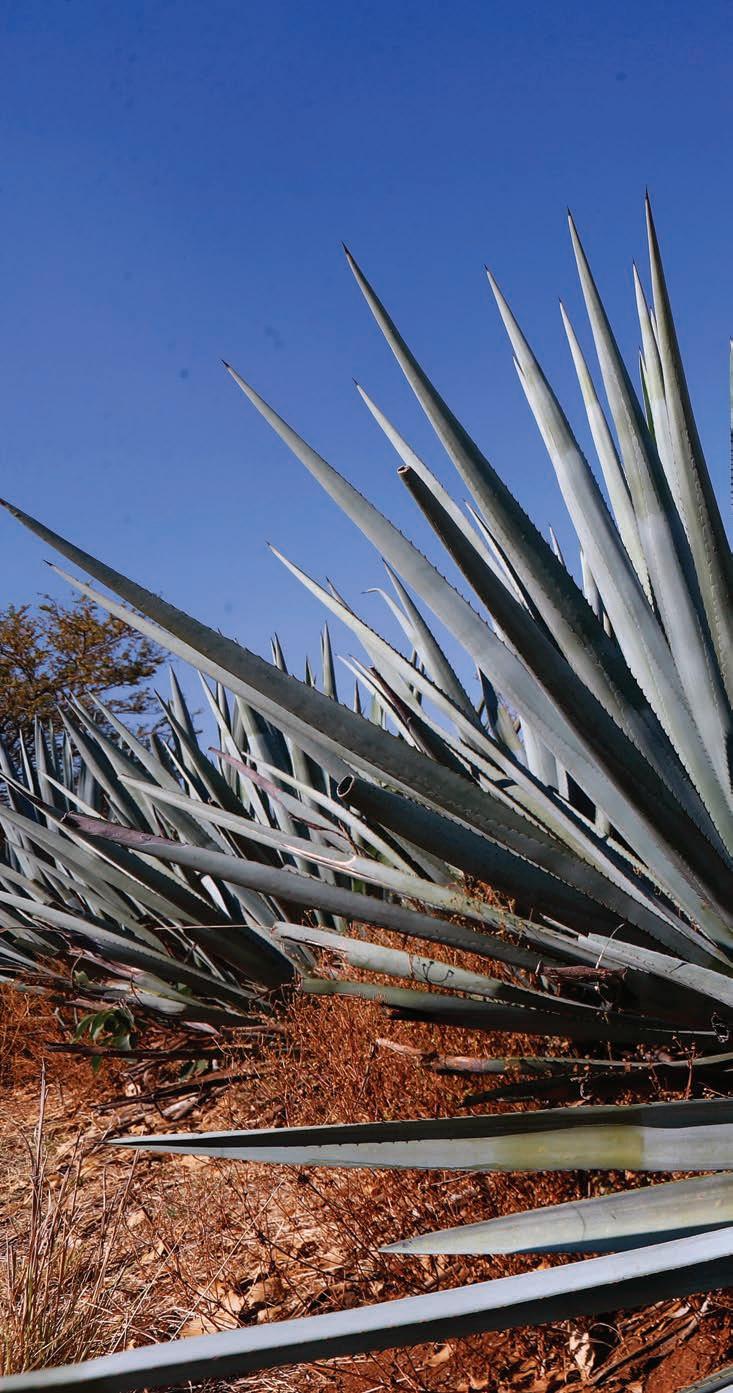
comfort zone, so keep an eye out for local festivals. My friend and I once had an amazing experience at one in Irvine.
Yes, Irvine.
And one of the tequilas I tried that day, Grand Mayan Ultra Aged, has been a
favorite since.
Drink what you like
Tequila snobs — like me — are every bit as bad as the oenophiles who dismiss the red blend you love with an expert swirl of their Burgundy. We
PHOTO COURTESY OF GRAND MAYAN TEQUILA
PHOTO BY REFUGIO RUIZ, GETTY IMAGES
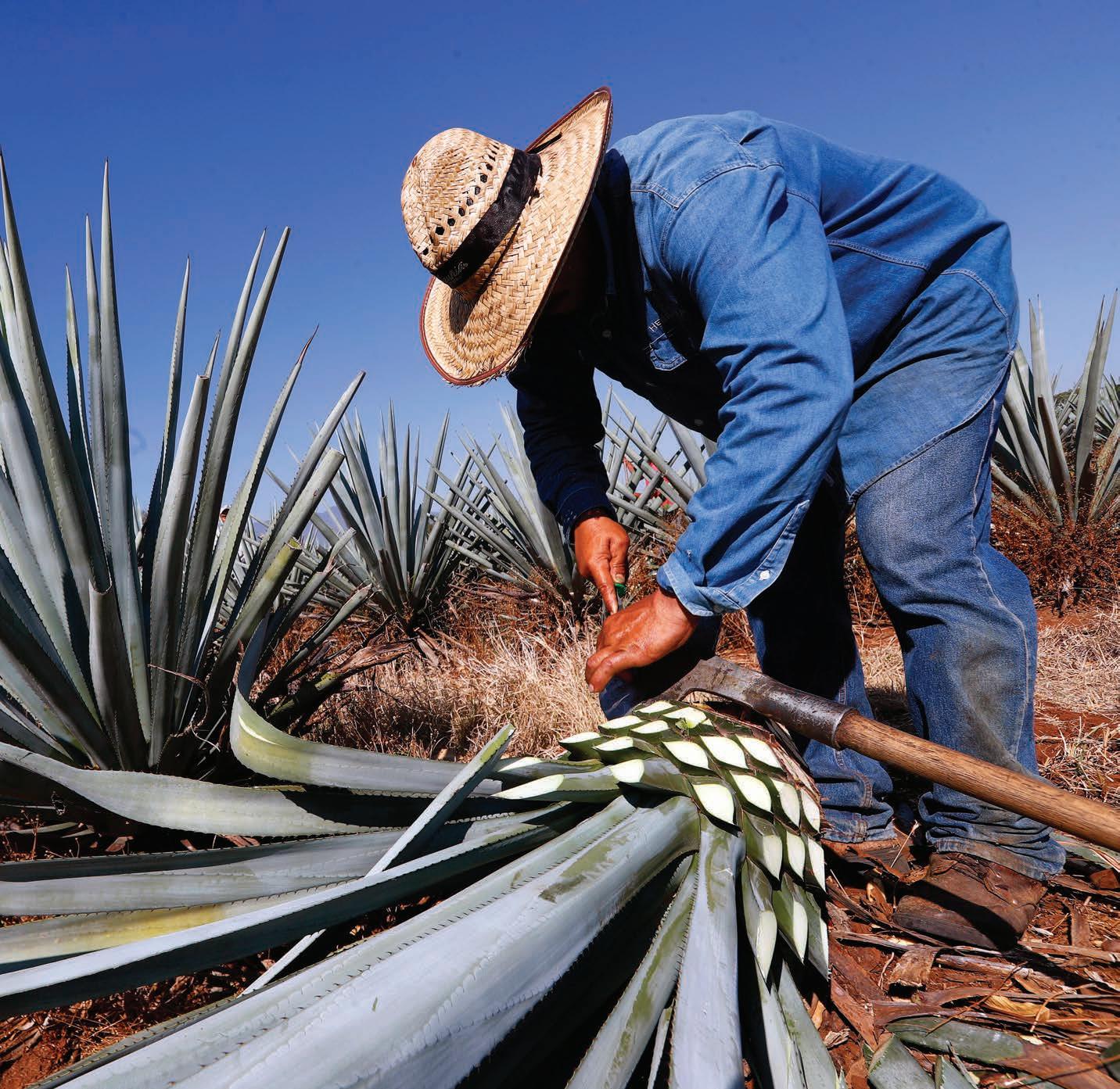
think we know what you should drink and are kind of obnoxious about it. What I’ve learned, though, is that most of us like something different. My late friend loved exquisite tequilas but couldn’t stand
the mezcals I also enjoy. Some need the sweetness of a pour with notes of caramel but others crave a savory or spicy finish. Don’t let elitists like me dictate what you should like. There might be some
reason you dislike one of my favorites, Tears of Llorona Extra Añejo, that has nothing to do with a major character flaw on your part. Possibly. Conversely, if you’re faced with a tequila you once shot at a party, do yourself a favor
and pass on the misery. Instead, find someone whose taste you trust, seek a recommendation and keep trying until you discover a tequila you truly enjoy … and doesn’t remind you of college.
How to plants
eat more
A lifelong meat-eater decided to go herbivore. Here’s what she learned.
BY TONI SCIACQUA
Weeks after I moved my first child into her college freshman dorm, I decided to go “vegan.”
This means different things to different people. I didn’t know that at the time.
I actually think meat and cheese are delicious, but I wanted a healthier lifestyle. I’m not a nutritionist, I’m just a woman who reads too much and loves a research project.
What I learned is that scientists and doctors are in general agreement that eating less red meat, fewer processed foods and getting more plants and fiber into your body is a good thing.
I was surprised to learn
that vegans don’t eat honey, and that there is debate about avocados and almonds because they require the employment of bees.
Semantics, apparently, mattered in this journey. Was I going to be vegan? Plant-based? Whole food plant-based with no oils? Did I have to buy organic? I didn’t want to get into the politics of it, I just wanted to feel better and live longer.
And, so, in what my husband said was the most surprising move since I dyed my hair purple a decade ago, I went mostly cold turkey – or was it tofurkey? I don’t know.
Now, I am not an intuitive cook. I don’t love it and I am not great at it. I once literally set my hair on fire making a box
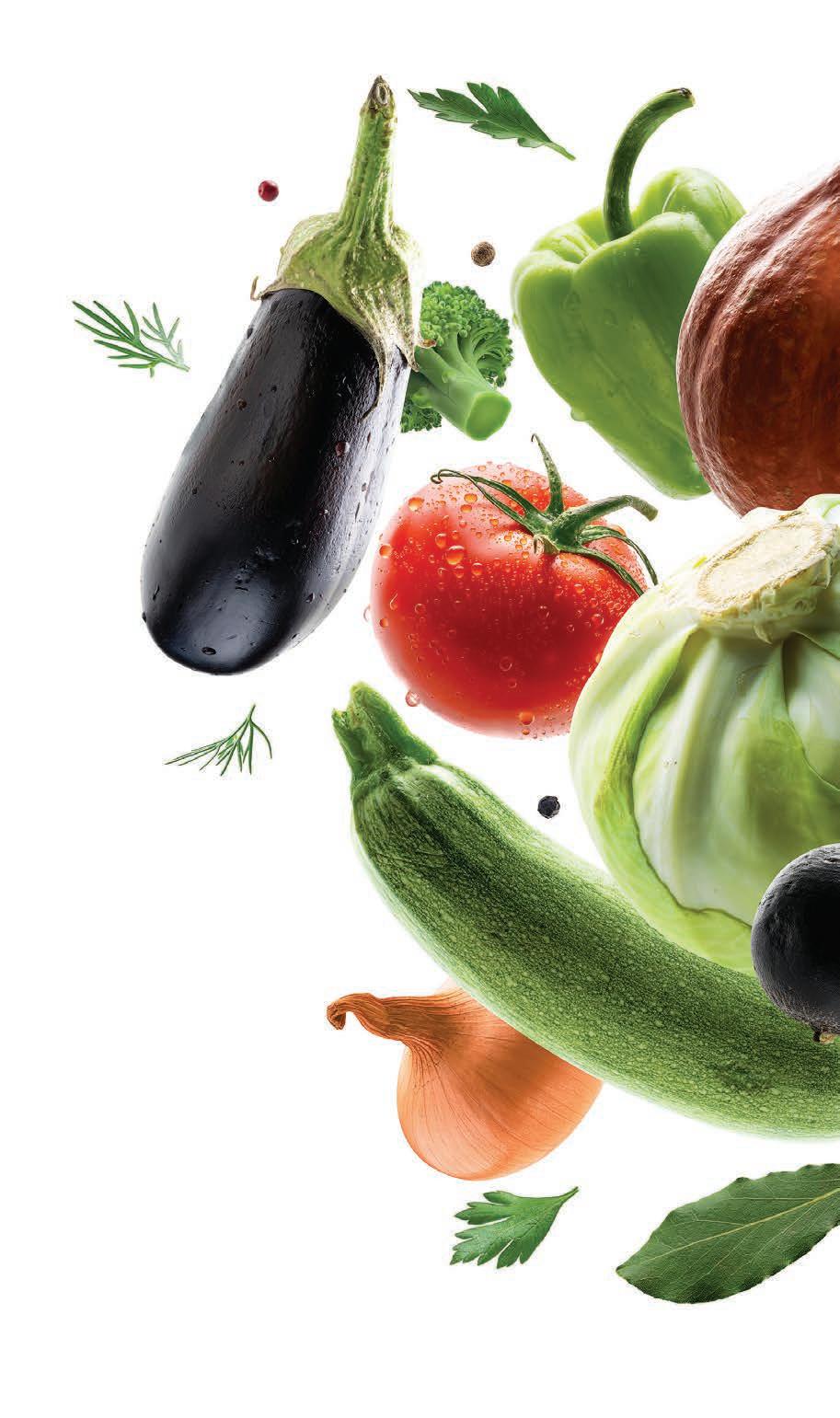
of Stove Top stuffing. So, my first move was to read a lot of books and blogs to plot my transformation. Since then, I have looked at dozens of cookbooks, tried hundreds of recipes and thrown out several pots full of slop in my quest to find an easy way to eat plants that are just as delicious as eating animals.
If you, too, want to make a run at it, the good news is you have several chances a day to try to eat more plants. Here’s how I did it.
Re-learn to cook I started out trying to
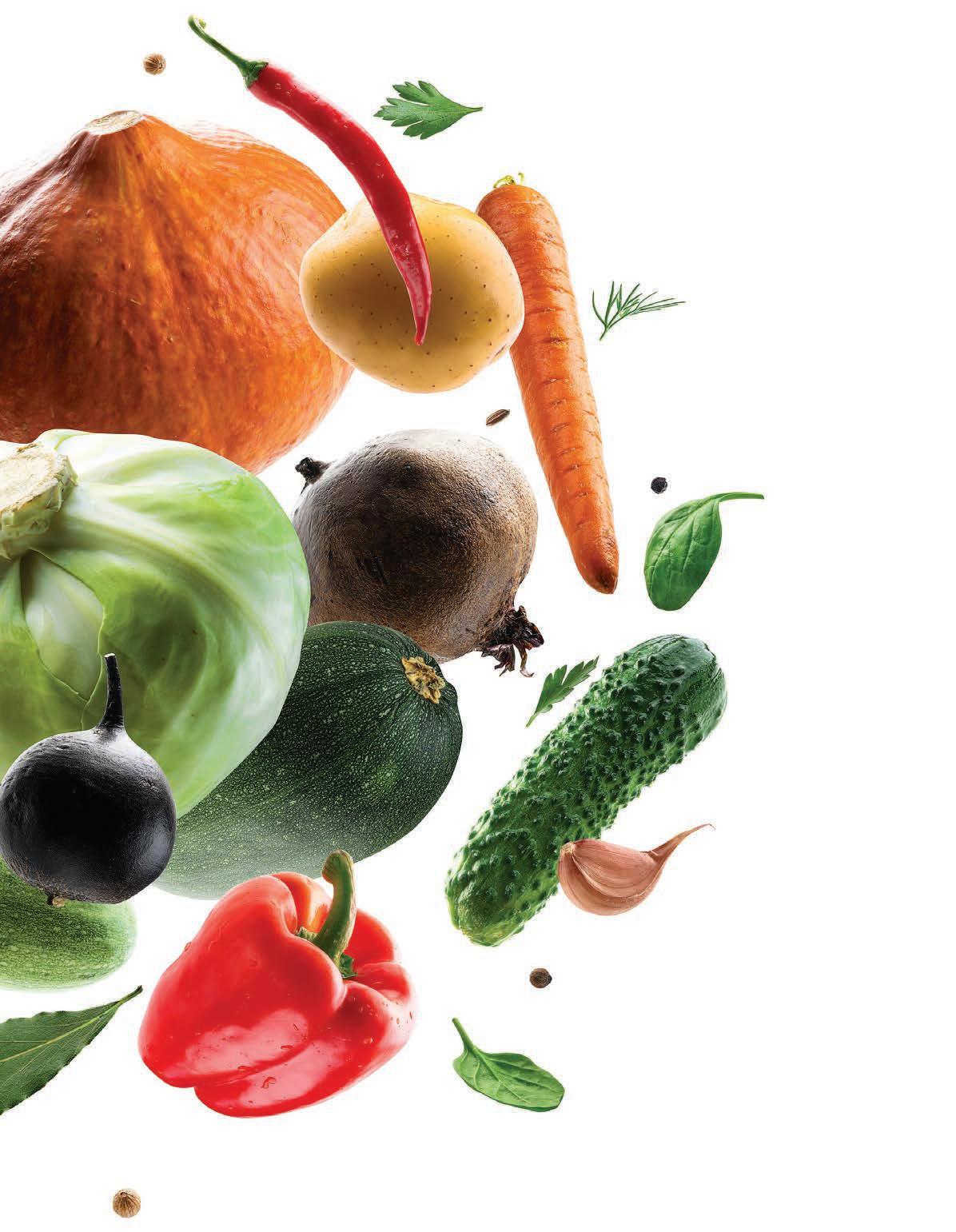
re-create meat-based dishes with plant substitutes. That is not the way. Instead, it’s better to find plants and flavors you like prepared in a way that highlights them to best advantage. Use cookbooks, Pinterest, TikTok and Instagram. I can’t cook from a video, I need a printedout recipe, which makes my kids roll their eyes at me, but whatever. The proof is in the pudding. Use the library. I checked out many books and then sampled a couple recipes from each.
Over time, you’ll see how trends have changed and what a wide range of “plantbased” options there are, some of which have very little health factored in. Eventually, I zeroed in on books written by nutritionists focused on protein and balanced meals. I also chose books that taught fundamentals. A few favorites:
• “The Complete PlantBased Cookbook” from America’s Test Kitchen. They also have a couple of others, but this is the one I use most.
• “Power Plates” by Gena Hamshaw
• “Peaceful Kitchen” by Catherine Perez
Look for splattered pages and broken spines that flop open to certain pages. They give a clue as to what previous chefs thought were the gems in the book. I try those.
Rethink the rules. For example: Eggless baking is easy. Sub with aquafaba (save your chickpea water!), bananas, applesauce, flax seed, vegan yogurt. Even my husband will eat the vegan baked goods, and he is a very picky skeptic.
Try cuisines from around the world: Indian, Ethiopian, Asian, Mediterranean. Anything other than American food probably has more veggies and plant proteins in it. Get a good spice collection and go crazy. Get a decent blender.
If you’re going to turn nuts into cream cheese, sharp blades have got to whirl. My dressings and soups were never so smooth as when I got a Ninja.
Keep notes of what you like. I tried so many “baked bean” recipes that sometimes it was hard to remember which one I liked or where I found the link for the one with the peppers. Now, I have a spreadsheet with every recipe I try and a favorites list so I can find them again.
Try again. I know it’s good for me, but I hated oatmeal. It tasted like paper pulp, and I have bad memories of being forced to eat cold, congealed ickiness as a kid, so I avoided all oatmeal-like things until I went plantbased and needed a go-to breakfast. Lo and behold: Baked oatmeal is like cake for breakfast! Then I made my way to overnight oats and eventually to hot oatmeal; now I’ve overcome my aversion and can’t believe I shunned it so long. If you keep trying, you will find a way to make the food in a way that works for you. (I’m still working on kale.)
Plan ahead
The hardest thing, for me, was simply finding something to eat when I needed to eat. I’m the kind of person who gets wrapped up in work and then surfaces 10 hours later and realizes I’m starving. In the plantbased world, it’s much harder to rely on fast food or frozen dinners, and some of the recipes I found early on were very convoluted, involving making whole layers of components and scouring grocery aisles for special ingredients, so I was too hangry to bother. I quickly figured out that I need to plan ahead. Now, I meal prep in ways that have evolved over the years: Occasionally, when I am feeling industrious, I make a big day of it and batch cook lots of things. Once, I made six different soups in a day while blaring all the great grunge albums of 1994 in my kitchen. Then I froze individual portions and had soup in the freezer for months. Ditto for burritos, smoothies and casseroles.
On Sundays, I prep at least one lunch and one dinner for the week. Maybe I’ll add a breakfast and a snack. But, it can get boring to eat the same thing every day for a week. So… I talked a curious friend into a weekly “vegan lunch
club,” where we both meal prep and then I give half my meals to her and she gives half of hers to me and we both get some variety, with the added bonus of trying double the recipes and chitchating every Sunday afternoon.
Try meal subscription services. Early on, I tried Thistle, Daily Harvest, Hungry Root and Oats Overnight. It was more expensive than making food myself, but took some of the burden of finding recipes, trying new ingredients and figuring out what I like off my list.
Order your groceries. I started doing this during the pandemic and never went back. I make a list in the Ralphs app and swing by to pick up the order on Saturday morning after my exercise class. It’s a free service, and the advantage for me is that it lets someone else who knows the store figure out which aisle goji berries and nutritional yeast are on.
Stock the pantry. Nutritional yeast aside, I’ve learned to keep it simple and avoid recipes with bizarre ingredients, but cooking plant-based does require a different pantry. I try never to run out of nuts and nut butters, canned beans of many varieties, grains and pastas. If all else fails, I can make hummus or a curry chickpea sandwich in minutes.
Dining out
Restaurant dining can be more expensive and it can be hard to find good vegan options that go beyond a green salad. Here are some tips, high and low:
• Coffee places often upcharge for milk alternatives, but Starbucks recently changed its policy. Also good to know: Soy milk for lattes has the same amount of protein as cow milk.
• Taco Bell has a secret code word for “hold the dairy.” If
you order “al fresco,” they’ll take out the dairy and add fresh diced tomatoes.
• Chef Tara Punzone’s Pura Vita in LA routinely wins awards for best vegan Italian restaurant. The recently closed Redondo Beach location was where I went when I wanted to feast. Fortunately, Punzone has a cookbook coming this fall. I pre-ordered at puravitalosangeles.com.
The worst meal to try to get as a vegan is brunch, because almost everything has eggs. And I love eggs. Eggs were probably the hardest thing to give up. Long Beach has a great vegan brunch/lunch spot, The Wild Chive. And Martha’s in Hermosa will sub eggs for tofu and avocado for cheese in their breakfast burrito. I do it often.
If your co-workers want to go to a steak place for a holiday dinner, order all the veggie side dishes. Roasted cauliflower is delicious. Other places I love:
Lil’ Vegerie: lilvegerie.com
Monty’s Goodburger: montysgoodburger.com
Salt & Straw: saltandstraw. com/collections/dairy-freevegan
Nekter smoothies: nekterjuicebar.com
Beach Bowls for acai: acaibowl.com (owned by a former Daily Breeze reporter)
Be open to life
One of the biggest obstacles preventing people from moving to a plantbased diet is the fear of missing out on personal or cultural experiences. Maybe you can’t imagine Thanksgiving without a turkey. Maybe your mom makes the best spaghetti and meatballs in the world and you would be heartbroken to never eat them again. Maybe your dream is to have fondue in the Alps. I just don’t worry about it, and call myself a “mostly” plant-based eater.
I’ve broken rank now and
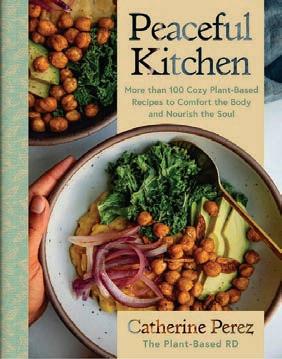


then. On a trip to Louisiana with my son I tried crawfish. In Houston, we had barbecue. In Hawaii, at my daughter’s recent college graduation, I had Kalua Pig. I’m not going to pass up a once-in-a-lifetime meal for the sake of a “vegan” label. But the point is, I could. At this point, I rarely miss meat or cheese. I feel great, I eat well, and grilled portobellos are really good.
How to be a Super Commuter
Take the advice of someone who has spent thousands of hours on Southern California’s not-so-open roads
BY KIMBERLY GUIMARIN
Driving in Southern California is not for everyone.
I mean, it is for everyone if you live here. Because it’s hard to get around in the region without getting behind the wheel of a vehicle at some point.
Sure, there are public transportation options, but let’s face it, the timing isn’t
always convenient, and sometimes safety can be an issue. There are rideshare options too, but cost and, again, safety, can come into question.
But road warriors — those who can settle into the driver’s seat and prepare for hours of brake lights and lane merging (only to learn that it’s now the slowest-moving lane because you are now in it) — deserve a pat on the back.
Patience, and
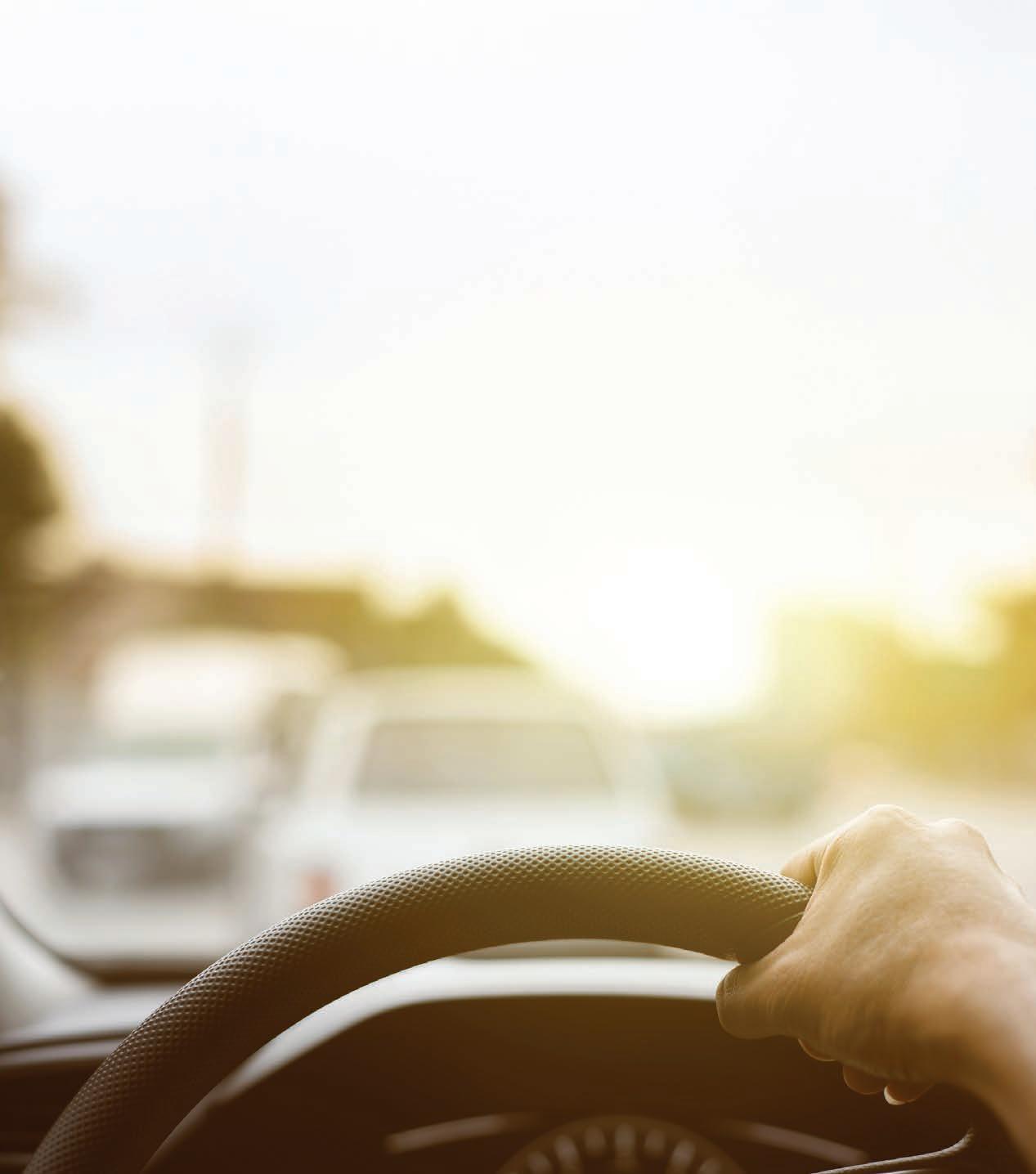
perhaps some deep breathing exercises, can help too, especially when you know you’re about to set out on a trek.
Don’t think you can hop into the car at 7 a.m. on a Monday and head for a meeting in downtown L.A. without a plan.
For years, hourslong commutes were the norm for me. I have made morning commutes that rivaled a drive — in distance — to the Mexico
BY

border. Hemet to Woodland Hills is a trek, 117 miles. Hemet to Tijuana, Mexico, 102 miles.
I had a boss who used to tell me, I could get to Mexico faster than to our Woodland Hills office. He was not wrong.
So, as someone who has spent thousands of hours — yes, literally thousands — behind the wheel on roadways across Southern California in nearly 20 years of commuting hours a day, here’s what I learned along the way. I consider it a win if these tips can help make your time spent in the car a little less stressful and a little more — dare I say it — enjoyable.
Timing
Your commute will take time. And in many cases more time than you plan for. Give yourself 30 minutes more than you think you need, to ease
stress and curb worry. When you know you have someplace to be at a certain time, you’re already feeling more pressure, so allowing yourself extra time is helpful and calming.
Look at Waze or Google Maps days in advance of your drive, if possible. Try to get a sense of what you can expect. If you’re planning for later in the week, or even next week, check a few different times to see what traffic patterns are like.
An advance peek at the apps also can help you familiarize yourself with the route. We’re not toting around Thomas Guides anymore, nor are we printing out MapQuest directions. We are fortunate that we now have access to real-time mapping software that helps us navigate and lets us know with pretty good accuracy how long our drive is going to take. I know
sometimes the “ignorance is bliss” mantra feels easier, but when an appointment or meeting is looming, ignorance is nothing but more stress. Arm yourself with information and stay in the know. Managing the overwhelm of a drive, which can grow longer with an unexpected hours-long SigAlert or a midday freeway lane closure for potholes to be filled, feels a little less daunting when you see those things pop up. Knowing is half the battle.
Fill ’er up
Do not wait until the morning you’re rolling out to fill your tank. Do it the day before you need to hit the road. The same goes for EV charging.
A full tank and a full charge are what you need, as you never really know what you’ll
PHOTO
JEFF GRITCHEN, SCNG
Timing your communte right can help avoid peak congestion.

be up against once you set out.
Chances are you’re already rushed in the morning; adding a stop for gas, one that could have been avoided, is not what you need. Save yourself the stress of that additional stop in the morning.
If you drive electric, it’s good to know in advance where charging stations are. Better to have the information and not need it, than need it and not have it. Find locations at driveelectric.gov/stations. Also, PlugShare and A Better Routeplanner are two apps that are both great for long-distance drives and even road trips.
Listen up
Many of us have podcasts in our queue or music
playlists organized by theme. Download them to your smartphone before departing to help get you through your drive. Or, create a custom playlist for sitting in traffic; “Highway to Hell” and “On the Road Again” are two songs worth considering.
Traffic is a good place to get some reading done — via audiobooks, that is. They’re great when you know you’re going to be a captive audience for a few hours. What books are on your TBR list? Find them in audio form and have them ready. Libby, the free library app, lets you listen to audiobooks at no cost.
Traditional radio, of course, is always an option. If you’re traveling outside your normal area, where your preset stations fall out of range, you’ll be scanning for other options to catch your attention.
For me, NPR is a go-to. As a journalist, I want to be in the know, though I understand listening to Leila Fadel and Steve Inskeep in the morning may not be for everyone. Maybe sometimes this is where the “ignorance is bliss” mantra does come in handy.
And of course, there’s usually a good sports game on AM radio. For me it’s baseball. There’s nothing like that hot summer evening in stop-and-go traffic with your window down and a ball game on the radio.
Options are good, and be sure to know yours.
Snack time
Do not leave home without some extra snacks to get you through.
Sure, you ate a big breakfast, had your coffee and don’t feel hungry. It doesn’t matter. I can guarantee if you’re in the car for an hour-plus, you will start to feel hungry, and also even bored, at some point. And don’t forget about that
drive back home — hours after you had lunch. You may have plans to stop for food on your return, but then you decide that getting home sooner is your new priority; it’s easier to do that if you have snacks.
What to pack? Jerky, granola bar, banana — anything that is easy to eat with one hand and with minimal crumb and spillage concerns. Do not take chocolate. I quickly learned my lesson there, when a piece inevitably falls, whether you notice it or not, and melts leaving marks on your clothing in places where you would prefer not to have dark stains.
Also, water. Have it ready. Fill the water bottle, have a disposable option.
Potty time
Face it, we all have been there. Stuck in traffic and needing to go.
Commuting through two pregnancies, I knew the locations of practically every bathroom along my route — the ones you have to make a purchase or need a code to access, and the ones you could walk right in and use.
Online lists and Reddit threads rank bathrooms and their cleanliness, but really, knowing the places with public restrooms is key. Most fast-food restaurants have them, but they often require codes to enter, as do many coffee shops. Big-box stores mostly allow you to walk right in and use; they’re most-often located somewhere near the front entrance.
Gas stations also have facilities, but they can be sketchy depending on location and time of day.
Check out the many apps now available — including Flush, Bathroom Scout, SitOrSquat, Toilet Finder, and Gotta-Go! — but you might find the information isn’t always relevant or up to date.
My best advice: If you must stop, be aware of where you are and your surroundings. Empty before you hit the road.
Not
so open road
Rush hour is rough. You and countless others are hitting the road at the exact same time.
Consider shifting a little earlier, or a little later. It’s amazing what 30 minutes on either end can do when it comes to time spent on the road. Watching the travel time change on map apps as you drive, increasing by a few minutes every few minutes, is stressful.
In stop-and-go traffic, use the lane semitrucks are in — they move. You might think all those trucks keep traffic backed up, but they are often still moving, however slowly, while other lanes are stopped. Those trucks stay in low gears and inch along; you can inch along with them at and least keep moving. It may seem that whatever lane you’re in is moving the slowest, as you watch cars in other lanes zip past. Sometimes, other lanes do appear to be moving along while you’re at a standstill, but quite often their delay is coming … it’s just that it’s, well, delayed. Hopping between lanes rarely pays off. Stay put and breathe.
Pro tip: If Fastrak lanes exist on your route, splurge on the transponder. No, you may not want to pay every time you’re on the road, but having the option to dip into the designated lanes and get up to freeway speeds when thousands of your closest friends on the road are sitting still, is worth it in my book. Time is money. Making the most of the time — however long it takes — and preparing yourself are key. It will take time, don’t fight it. Arm yourself with knowledge and snacks. And good luck out there on the roadways.
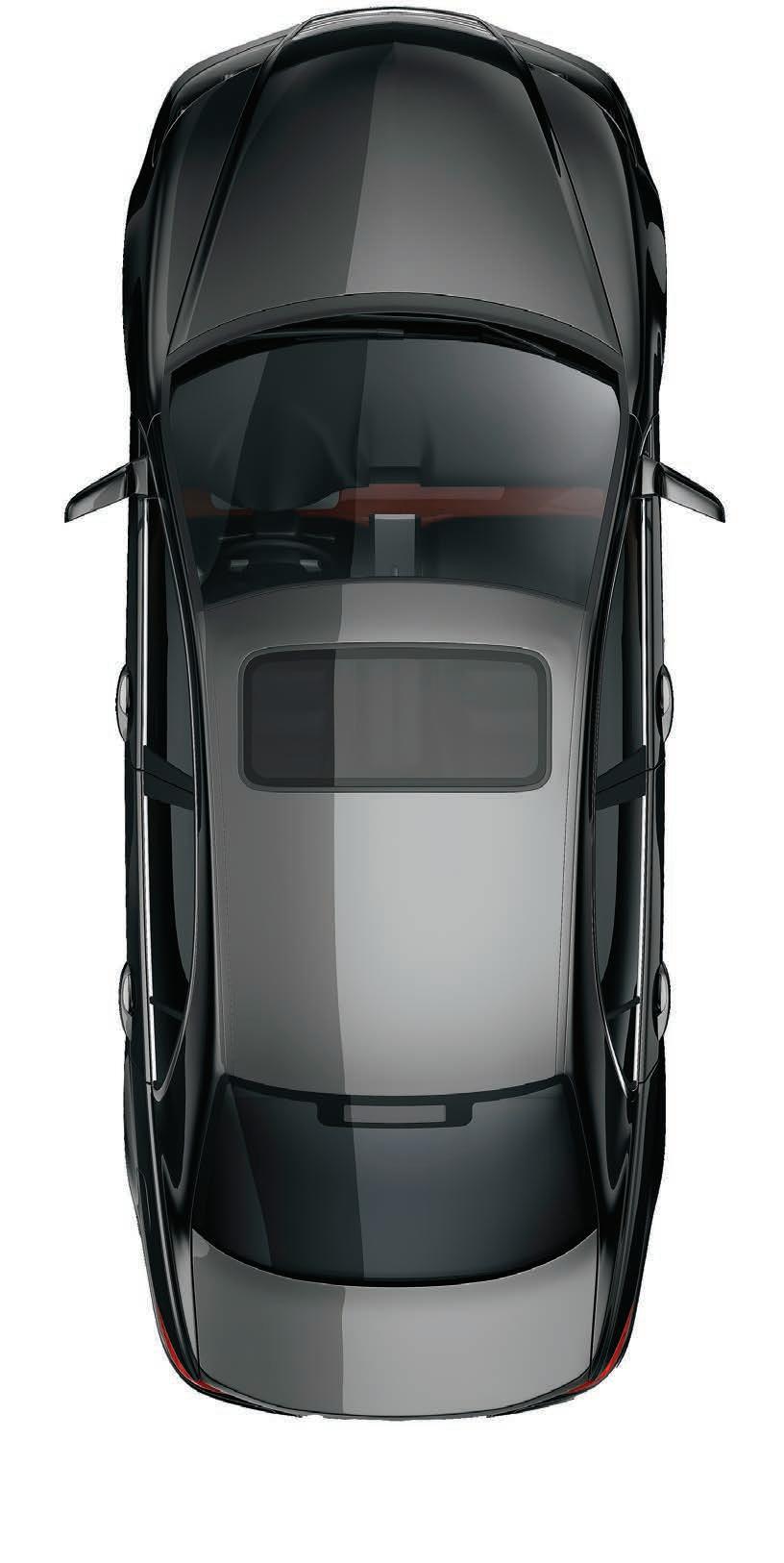
How to buy a good used car for cheap
Yes, it’s possible – if you know
these simple tricks
BY JIMMY CAMP
Iknow that buying a used car can be a daunting experience, especially if you’re trying to purchase it from an unknown third-party, but let me tell you about a few tricks I’ve learned over the years.
There are pros and cons to buying from a private seller versus buying from a dealer or a used car lot. Purchasing a vehicle from a dealer can be anywhere from 10-30% higher than buying from an individual. Luckily, there are certain steps you can take to mitigate the risks of buying from a third-party seller. In my experience, if you are patient, diligent and persistent, you can find a good, reliable vehicle that you’ll be happy with.
The most obvious issue with buying from a stranger is safety. Unfortunately, there are scammers everywhere these days, especially online. My first rule when going to look at a vehicle is to pick a public location — that you choose — to meet the seller. The seller knows you might be showing up with a large amount of
cash. And second, never go alone. If you have, say, a very large, mean-looking biker friend, have them accompany you. Plus, if you end up buying the car, you won’t be stuck trying to figure out how to get home with two cars. There are several online classified sources for buying used cars, but I’ve consistently had the best luck using Craigslist. So while there are many other good, reputable sources out there, for the sake of consistency, I’ll be referring to Craigslist throughout this article. Disclaimer: I’m not a mechanic or a car collector. I’ve never worked in the automobile industry in any way, shape or form. But in the 44 years since I started driving, I’ve bought more than 100 cars, ranging from classic collectables to newer used cars, and everything in between. Sometimes those purchases worked out well for me, and sometimes they didn’t. I’ve learned a lot from both the good and the bad, so here are the four steps I now take when buying a used vehicle, based solely on my personal experiences.
Decide exactly what your budget is
People often ask, “How much is it worth?” The tongue-in-cheek answer is usually, “It’s worth whatever someone’s willing to pay for it.” But that’s not exactly true. When purchasing a car, it’s worth somewhere between what a buyer is willing to pay for it, and what a seller is willing to take to part with it.
Before looking at any car, decide exactly what your maximum budget is, and then begin looking for your car at 20% above your drop-dead maximum price. For example, if your hard budget is $10,000, set your search at $12,000. In my experience, most sellers list a car at a price they are “hoping” to get and are usually willing to negotiate. If you find a car you like that’s above your budget, try negotiating it down to your price. The exception is when a listing says “NON-NEGOTIABLE,” “PRICE IS FIRM” or “NO LOW-BALLERS.” These are usually people I don’t want to deal with anyway, so I skip these ads.
Identify the specific car you want
As of this writing, there are currently 1,160 Toyota Camrys listed on Craigslist in Southern California alone, ranging in price from $805 to $50,000. Obviously way too many to consider. Do some research to identify what features you want, narrow it down to a manufacturer, a model, a year range, and your price range.
You’re much better off looking for a specific car rather than having multiple makes and models in mind. Google can be your best friend when buying a car, and it’s important to do your research. Once you’ve identified a make and model, Google if that car had any ongoing safety or mechanical issues for certain years and avoid those years. You might find a really nice 1973 Ford Pinto (my very first car) that you just can’t live without. But after a Google search, you’ll learn that 1971-1976 Pintos had some serious issues with the fuel tank that you probably couldn’t live with. Unless you’re looking for cars that literally explode, that is.
Find your car
Don’t buy the first car you see. Look at and drive multiple cars. Doing this will give you additional insight into what you may and may not like about a certain vehicle. I try to give myself at least a month of looking, driving and evaluating before I make a decision. And, yes, many of the cars you’ve looked at may be sold during that time. But, that’s not necessarily a bad thing. If you keep track of what cars you’ve looked at, the asking price, and how long it took to sell, this will give you an idea of what the current market price is for that car.
Buy your car
There are several factors most people, including myself, take into consideration when deciding to buy a vehicle. Here is what I think is the order of importance:
EXTERIOR
Paint and body condition are usually the first thing you see when looking at a vehicle, and it is often how people evaluate a car. Depending on the age of a car, there will be a certain amount of deterioration to the paint due to exposure to the elements. Most of this is out of the control of the previous owner, so rather than looking at issues out of the owner’s control, I look for signs of owner neglect. Is the car dirty? Are the wiper blades old? Is there an unusual amount of door dings on both sides? This tells me that the owner doesn’t take very good care of their car, and if they don’t take care of these minor things, they probably don’t take care of major things like oil changes and brake maintenance.
INTERIOR
Same premise as the exterior, but even more important: Don’t buy a car with a neglected interior. I’m not talking about usual wear and tear. I’m talking about cigarette burns in the upholstery, 2-year-old french fries between the seats, spilled coffee stains on the carpet. These are signs that the owner doesn’t care about the car, and you don’t want a car that wasn’t cared for.
MECHANICS

This includes the engine, transmission, brakes and more. This is the defining factor I consider when buying a car. There are a couple important ways to ensure that the vehicle you are considering is mechanically sound:
First are receipts. If someone has kept their maintenance receipts, showing regular oil changes, etc., I’m more likely to buy that car. If someone tells you they had the brakes done last month, but they don’t have a receipt, the work possibly never happened. The second thing to do is take it to a mechanic you trust for a complete diagnostic evaluation. This will cost anywhere from $40 to $500 depending on how thoroughly you want your mechanic to dig. I believe it’s worth every penny to find out that the car you might buy is in need of major, expensive repairs. If the seller isn’t willing to let you take the car to your mechanic, don’t buy it. This also can be used as a negotiating tool: If you find the car is in need of some minor things, you can get the seller to knock the cost off the asking price.
Hopefully that’s enough to get you on the road safely, and economically. Like I said, this approach has worked for me over many years. Patience, diligence and perseverance will serve you well. Now, excuse me while I go look for a 2005 Ford Thunderbird … my wife wants one.

The first Formula One race I ever watched was out of spite.
A few years ago, my partner and I had one of those very spirited and totally harmonious discussions about whether we took an interest in each other’s interests. We were in a long-distance relationship at the time, apart by a couple of time zones, so quality time was a bit of a creative endeavor.
And while I’m sure I was completely selfless in sharing my time with his passions back then, still I sighed and acquiesced. I would make
this sacrifice, turn on the TV at an ungodly hour, watch some cars drive around in circles, and try to make sure I moved my head out of the FaceTime frame when I’d inevitably yawn.
I was wrong about the circles, but not the yawning.
The F1 calendar largely includes races in Europe and Asia, so live races are a bit at weird times for us West Coast folks.
But the lights! The fashion! The twists and turns of the race; did you guys know F1 courses aren’t just a bunch of left turns around an oval? Take Monaco, for
instance, where the street course winds through Monte Carlo with sharp corners, a dark tunnel, and elevation changes.
The drama!
It’s an assemblage of sports, politics and reality television. And I was instantly, inevitably, hooked.
But like any new passion, figuring out where to begin, just how to be an F1 fan, was a bit daunting.
F1 is a multibillion-dollar industry, where engineering is the name of the game. It has a reputation — for its fans and its drivers — of being a sport for the wealthy
elite or for men or for people who know just the basics of how a car works. (I fall into none of those categories.)
It has struggled with diversity and representation, including when it comes to having female drivers on the grid.
But where F1 doesn’t struggle is passion — especially among fans who are steering the sport’s reputation away from an archaic narrative that it’s only for the wealthy or men or both.
Among those evangelizing F1 and working to make the fandom more inclusive is my
Ferrari driver Lewis Hamilton of Britain steers his car during the Spanish Grand Prix Formula One race in Barcelona, Spain, in June.
How to learn to love Formula One
Sure, it seems like cars going in circles. But that’s only the beginning.
BY KAITLYN SCHALLHORN

friend Erin Wolfe, one of the people behind West Coast Formula Pit Crew, a group that hosts watch parties for races, meet-ups and other fun events on, you guessed it, the West Coast.
As she put it, F1 is “the perfect combination of insane talents and traveling circus. It’s a challenge, a human-made challenge, a human invention. It’s pure fun.”
Despite or maybe because of the intricate and delicate cars — if they so much as brush a wall or another car during a Grand Prix, that could be the end of
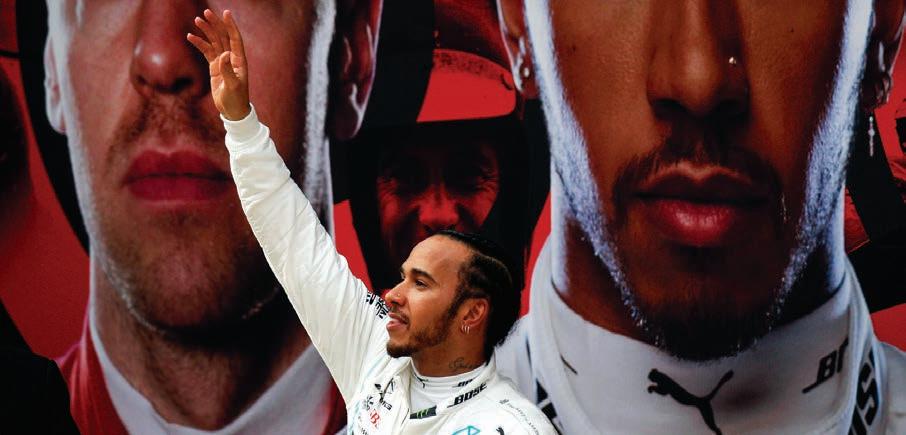
PHOTO BY JOAN
Mercedes driver Lewis Hamilton of Britain waves to his fans after winning the Chinese Formula One Grand Prix at the Shanghai International Circuit in Shanghai.
PHOTO BY ANDY WONG, ASSOCIATED PRESS
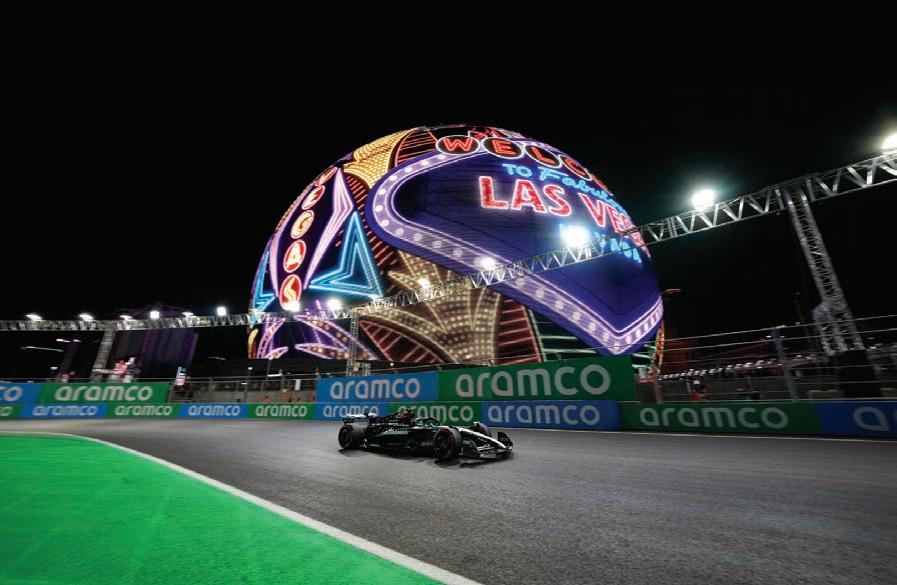
their race weekend — and mind-boggling speeds, F1 is a relatively easy obsession to adopt.
And it’s fun.
Sure, if you want to watch races live, you’ll be setting your alarm clocks to 5 or 6 a.m. to watch the race or qualifying — perhaps the most stressful part of race weekend where drivers compete in three stages, each trying to get the quickest lap around the track that will determine where on the grid they begin the race. But there’s coffee for that — or mimosas.
There are also more daylight-friendly activities.
Take Netflix’s “Drive to Survive,” which has brought many fans into the fold throughout the documentary series’ seven seasons. The show goes behind the scenes of the F1 world, into the paddock and in the rooms where team owners and principals — these people are sort of like coaches, but really managers, who oversee all aspects of the team, from the drivers to the engineers and other personnel — make
the decisions that decide the fate of the whole racing season.
There are myriad social media accounts on Instagram and TikTok, many run by women, that relay all the gossip from the grid — Who is dating who? Which drivers are best friends, and which ones are in a feud? — and they also break down strategies and why certain tires are better for certain races or simply explain just why we watched a driver be sprayed jubilantly with champagne only to get a dreaded ESPN push alert a few hours later, screaming that he was disqualified from the race, eliminating his team’s much-coveted points. And, oh yeah, they also explain how that point system works for drivers and for teams.
And this summer, there’s Brad Pitt.
I probably needn’t say more, but just in case: The Academy Award winner stars in “F1,” a redemption movie about an older driver who returns to the track.
Ferrari driver Lewis

Hamilton — arguably the greatest driver of all time — has worked on the movie and said it could be “the most authentic racing movie that’s ever been made.”
So yes, I was wrong — words I’ve barely needed to say during my years-long relationship.
But my partner may also have been wrong, or at least rueing the day he challenged me to take an interest in his motorsport interest.
Now I’m the one waking us up before the sun on weekends, incessantly sharing articles and social media posts — “Can you believe what Max Verstappen said?!” — and dragging him along to F1 events around Los Angeles.
It’s not really his fault.
I love sports, but I’m not a car girl. I excelled in science in school, but never had an interest in engineering.
I am definitely not a morning person.
But now I set my alarm, throw on something from the quickly increasing collection of Lewis Hamilton gear in my closet, and hold
my breath as the lights go out, and the drivers roar forward at the start of the race.
I press my foot, hard, into an imaginary pedal on the floor as my driver attempts to overtake his, our, arch rival.
I curse when my favorite driver crashes into a wall — for the both of us, since F1’s governing body has tried to prevent drivers from swearing themselves.
I jump up and cheer when my driver walks out for a podium celebration to receive his trophy, almost holding back tears when the camera cuts to his sobbingwith-joy parents.
I’m not sure if there’s any one thing that ignited such a deep passion for the world of F1. For sure, many of the drivers’ penchants for fashion help, as does the made-for-Bravo drama and the politics of it all. And there’s also the camaraderie that comes with sport — that collective celebration or downright despair at the end of the race.
I just know I’m glad I
Among the three remaining F1 races this year in North America is the Las Vegas Grand Prix, a night race that’s slated for Nov. 20-22.
PHOTO BY RICK SCUTERI, ASSOCIATED PRESS


was wrong.
Since becoming a fan, I’ve met countless new friends, many women who are armed with friendship bracelets to gift, sporting a team’s colors or a driver’s number or nickname.
And, with its Grand Prix in November, I have another excuse to visit Las Vegas every year.
For those who have read this far and are F1-curious, here are some nuggets to get you started:
• Being a Ferrari fan will inevitably break your heart.
• Several drivers have adorable dogs if you want to pick who to root for that way.
• Cadillac will have an F1 team next year in case you want to hold where you place your allegiance until then.
• And Laura Mueller with Haas made history this year as F1’s first female race engineer.
Also, have I mentioned yet: Lewis Hamilton is the greatest driver ever?
See you at the next race!
It’s lights out and away we go.

Brad Pitt stars in the recent film “F1,” revving up interest in the sport among American audiences.
Mercedes driver Lewis Hamilton of Britain celebrates after winning the British Formula One Grand Prix in England.
Middle: The prestigious Formula One Monaco Grand Prix has been held since 1929.
PHOTO BY MANU FERNANDEZ, ASSOCIATED PRESS
PHOTO BY LUCA BRUNO, ASSOCIATED PRESS
PHOTO BY BENJAMIN CREMEL, ASSOCIATED PRESS
Why you should be digging in the dirt
Your prescription for wellness? It’s in the garden.
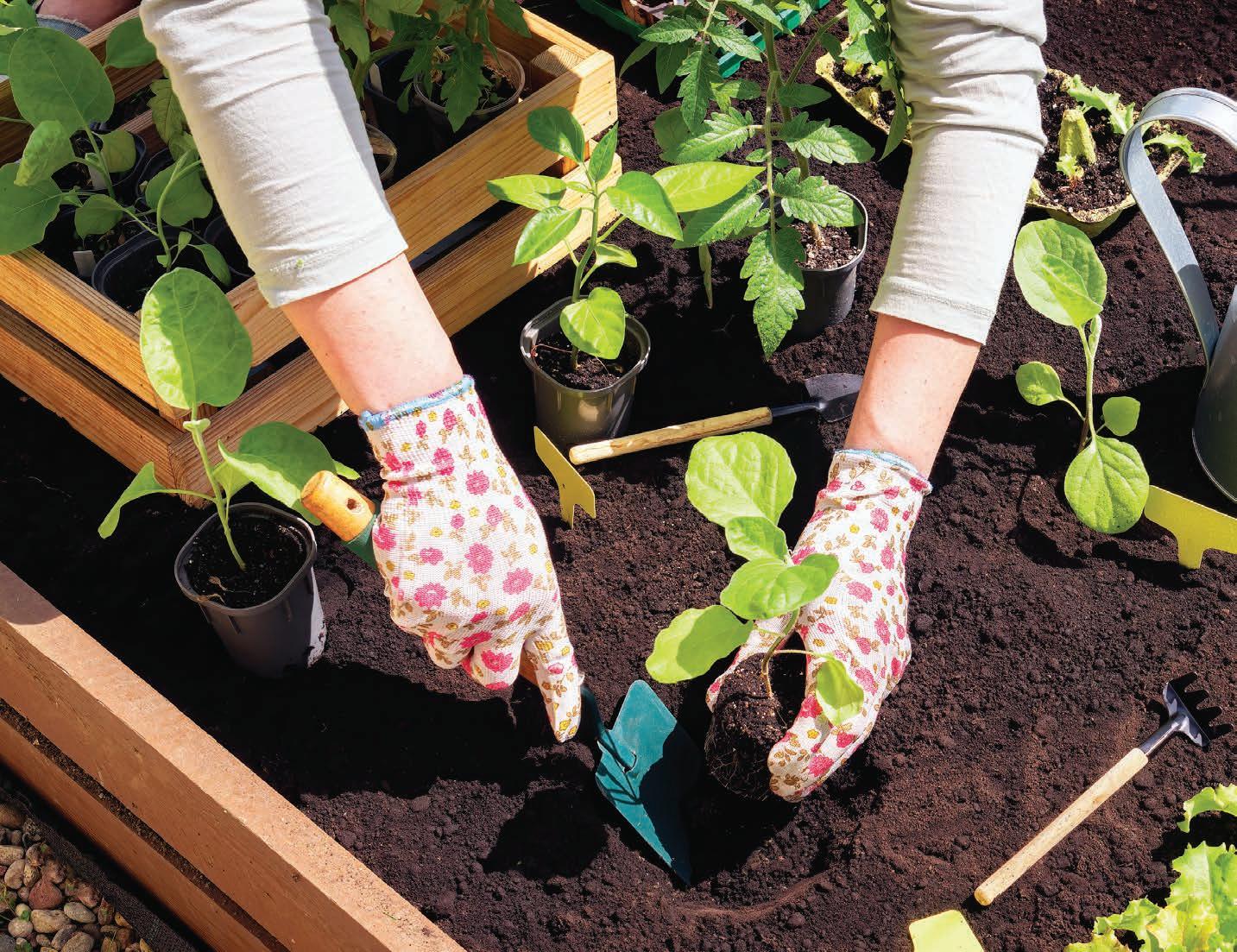
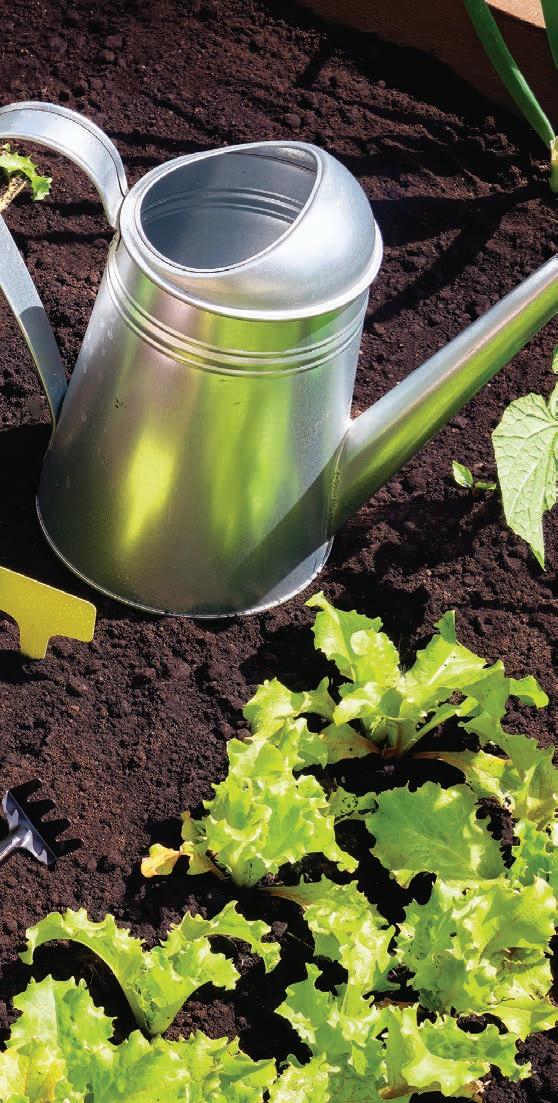
BY DANIELLE BAUTER
There’s a primal satisfaction to the act of digging into the earth. It begins with the firm, cool resistance of the topsoil, a dense layer yielding slowly to the purposeful push of fingers or the sturdy edge of a trowel. As you break through, you encounter the surprising warmth and crumbling richness of the layers beneath, occasionally punctuated by the stubborn tug of a root. This isn’t merely about moving soil; it’s a sensory immersion. In an age dominated by screens, constant connectivity and pervasive digital realities, this simple, grounding act embodies the internet’s playful yet profound directive to “touch grass.” While the phrase may have originated as a lighthearted nudge to unplug from online drama, its widespread adoption illustrates a deeper, often overlooked truth: our innate human need to interact with nature.
Feel the power of the soil
A growing body of research supports the intuitive connection we feel to the natural world, emphasizing tangible benefits like stress reduction, improved mood and even enhanced focus. The act of caring for something living can shift our focus outward, reducing internal stress.
And experts agree. “When you’re gardening, there is the excitement of the accomplishment, but then also at the same time you’re dealing with failure as well,” says Ciara Bogdanovic, the owner of Sagebrush Psychotherapy in Los Angeles.
“So there’s life lessons to be learned; about acceptance, about learning and growing. Like if you try to amend the soil, or move the plant to a different part of the garden where it has more sunlight. In that sense, I think it mirrors the challenges that we go through.”
It can help improve your stress level
Feel like you’re constantly running on empty? The garden might be your ultimate stressbuster. The rhythmic, repetitive motions of planting, weeding and watering serve as a form of active meditation, allowing your mind to quiet and focus on the present moment. Studies have shown that even short bursts of gardening can lead to a decrease in anxiety and an improved sense of wellbeing.
Colleen Culhane, the engagement manager at The Ecology Center, believes gardening can affect our mental state of being. While working at the 28-acre organic regenerative farm in San Juan Capistrano, she has witnessed the health benefits of connecting to the land and being present.
“Just from watching folks that come to The Ecology Center, often people say, ‘You step foot on this land, and it’s like your shoulders drop down.’ You’re breathing, it lowers your blood pressure. You just feel peaceful.”
It can help heal grief and trauma
Gardening can also offer a unique path through sorrow. When emotions are overwhelming, the garden provides a place
for quiet reflection and gentle action. The cyclical nature of growth, decay and renewal in a garden can be a profound metaphor for processing loss. The act of caring for something alive
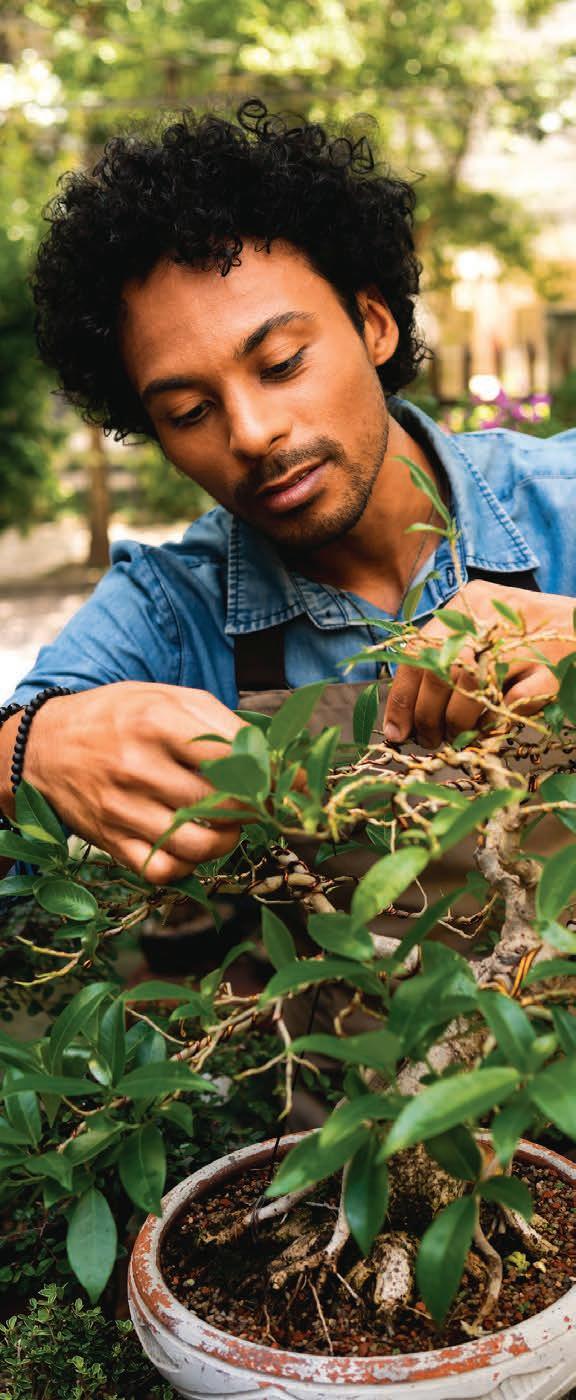
can also offer solace and a renewed sense of purpose during difficult times.
Barbara Lawson dealt with prolonged grief after her mother died of congestive heart failure. While going through therapy several years later, she completed a healing garden, where she was able to reconnect with herself and her mom. It was also the inspiration for the name of her plant business, Meet Me in the Dirt.
“It was in the garden that I met myself again. I was able to tap into who I really was at the core and reconnected with my mom,” Lawson says. “I had also gone through all of those things that I needed to bury and resurrect, and the dirt is what held what I could not.”
That experience affected Lawson so much that she decided to become a certified grief therapist. She also started offering grief workshops at her space in Redondo Beach, where she creates a festive atmosphere.
“It’s celebrating the bloom and burial,” she says. “All of those deserve attention, and they’re purposeful, so it’s allowing each of us to have access to those moments, and to not only focus on when things are all great and in bloom. But to also know that won’t happen unless you go through the burial period. It helps people to deal with change and transition a whole lot better.”
It can help with addiction
The demands of gardening can be incredibly beneficial for those who are currently recovering from addiction. The responsibility of caring for plants creates a sense of purpose and helps establish a routine. The delayed gratification of watching a plant bloom can be a lesson in patience
and perseverance.
Horticulture therapy, also known as garden therapy, is a holistic approach that addresses all aspects of one’s being — from physical and mental to emotional and social well-being. It uses the inherent connection we have with nature and the therapeutic process of working with plants as a means of supporting people on their sobriety journey.
Gardening activities require you to focus and stay in the present moment, whether you’re planting, weeding or watering plants. This promotes mindfulness, an important skill in addiction recovery that helps with managing cravings, processing emotions and resisting negative thought patterns.
It can help you feed yourself and others
Beyond its therapeutic benefits, you’ll also receive the undeniable satisfaction of feeding yourself. When you grow your own fruits, vegetables and herbs, you’ll have access to fresh produce, which reduces your reliance on often processed supermarket alternatives.
Growing your own food also promotes healthier eating habits. Community gardens, including The Ecology Center, create social connections, resulting in the simple joy that comes from working together to cultivate abundance.
In a society that prioritizes convenience and ultraprocessed foods, it’s difficult to know the origin of your ingredients. According to Culhane, “Even the fact of eating whole foods and just eating real food, that’s what our bodies are made to digest, and that’s where all the nourishment and the nutrients are. It’s the simple idea that eating from the land is what our body recognizes.”
It can help improve your cognitive function
Gardening also provides a robust workout for your brain. Whether you’re planning the layout of your garden, troubleshooting pest issues, or remembering planting schedules, it engages your cognitive functions. This constant mental stimulation can help improve focus, attention and even decrease the risk of cognitive decline.
“When it comes to any sort of mental health issues, any movement and physical activity is certainly going to assist and resolve some of that,” said Bogdanovic. “Like stagnancy, that stuckness that can occur, that shows up a lot. But there’s that other aspect of connecting with the elements, connecting with the soil.”
It can help you connect with nature
The ability to truly connect with nature can often feel out of reach, but gardening bridges that gap. By being immersed in our senses, it pulls us away from our thoughts and brings us into the present moment.
There’s an inherent magic in observing a tiny seed grow into a thriving plant that provides both food and beauty. This process can create a sense of awe and wonder, reminding you of nature’s resilience.
The feeling of rich soil sifting through our fingers, the way the earth smells after a rain, the sweet fragrance of blooming jasmine or ripening tomatoes, or the buzz of a busy bee — these are all immediate, tangible connections to nature. Often referred to as biophilia, this connection is vital for our health. It promotes a sense of wonder that can be lost in everyday life.
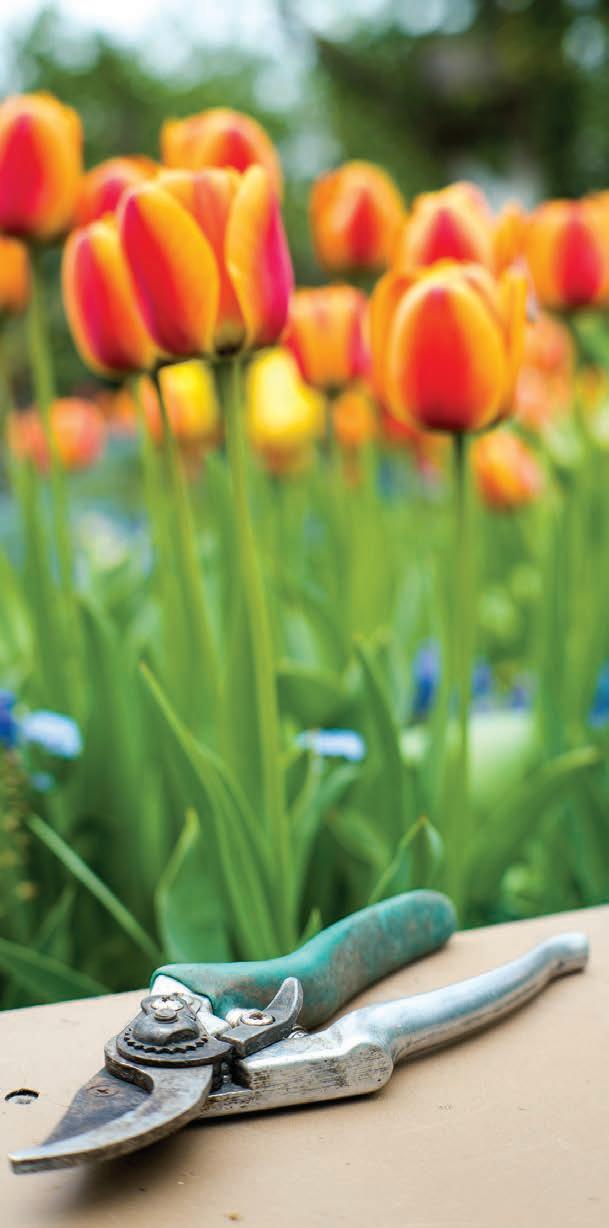
It can help boost your immunity
Getting your hands dirty might be one of the best ways to fortify your immune system. Soil contains microorganisms, like Mycobacterium vaccae, which studies suggest can act as a natural antidepressant and even boost your immune system. Plus, increased outdoor time means more Vitamin D exposure, which is important for bone density and your overall vitality. Culhane agrees. “When you’re working with healthy soil, that is incorporated into your gut biome. There’s actually a real benefit to interacting with the earth and the soil.”
It can help you move your body
Tired of the gym? Your garden offers a full-body workout without feeling like a chore. In fact, gardening is referred to as the “hidden workout” because you’re so engaged in the task that you don’t always realize the significant benefits you’re gaining.
Digging in the dirt, planting seeds, capturing weeds and even carrying watering cans all contribute to moderate physical activity. It’s a lowimpact way to be active and improve your overall physical health, which often leads to better sleep. So, the next time you feel the weight of the world on your shoulders, or crave a deeper connection to something real, consider going outside. Roll up your sleeves, put your hands in the soil, and discover the transformative power that lies in digging in the dirt. Your mind, body and spirit will thank you for it.
How to get your kids to love the movies
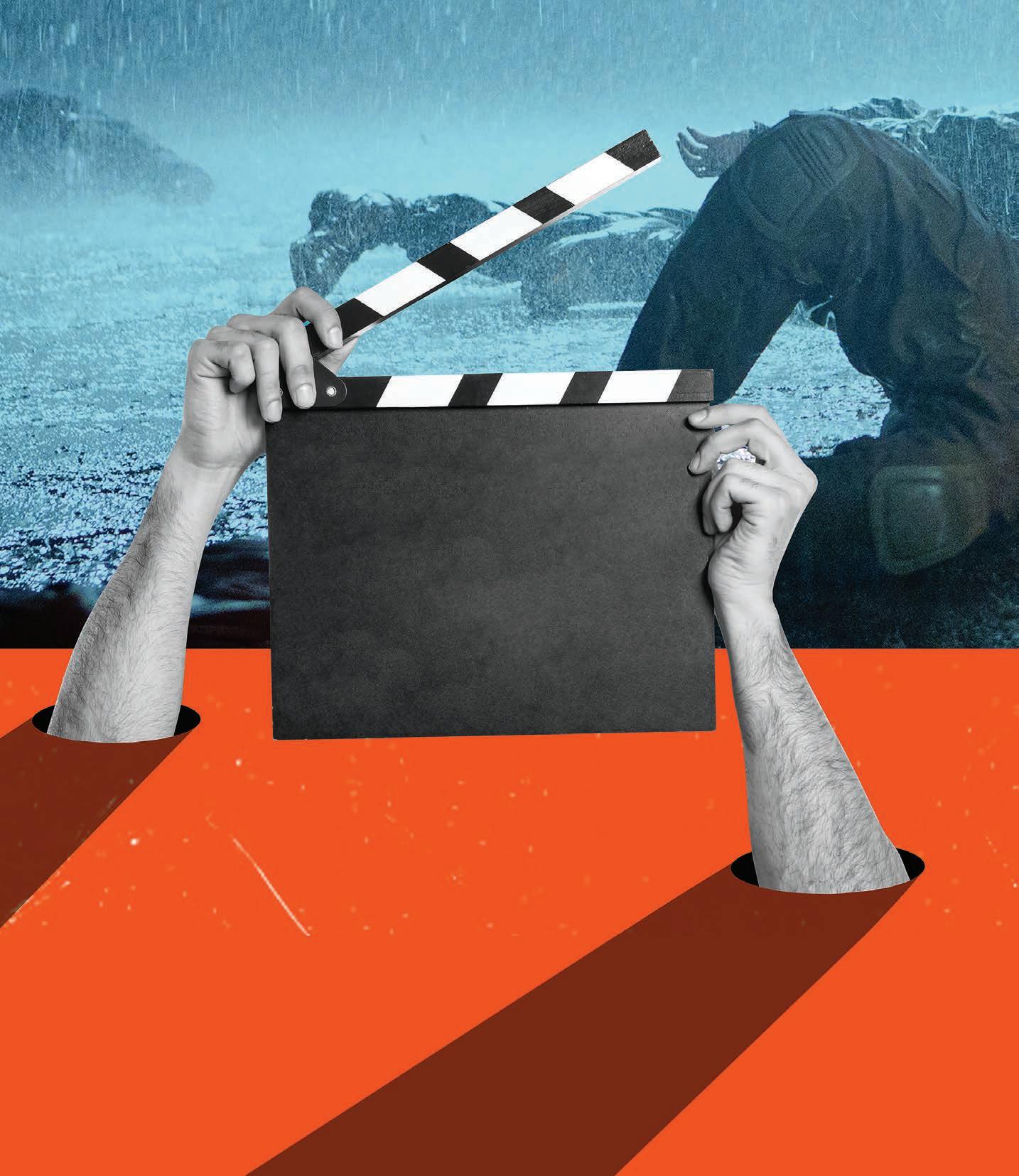
(Bad parenting or just luck? Does it matter?)
BY ANDRE MOUCHARD
INT: SUBURBAN LIVING ROOM. 2:24 AM. NOT A SCHOOL NIGHT.
The entire room is bathed in light from an IMPOSSIBLY BIG WIDE SCREEN TV playing gruesome scenes from “World War Z,” a 2013 zombie movie starring Brad Pitt. We scan to see two people on two couches. On one, FATHER, early 50s, OBVIOUSLY TERRIFIED, watches between spread fingers as a zombie contemplates eating Brad Pitt’s head. On the other, SON, 14, GRINS at the same scene, UTTERLY UNAFRAID. The movie ends. Father gets up and tosses a blanket over his presumably sleeping son. Then he clicks off the TV, casting the room into Bible-black darkness.
But as he tiptoes away…
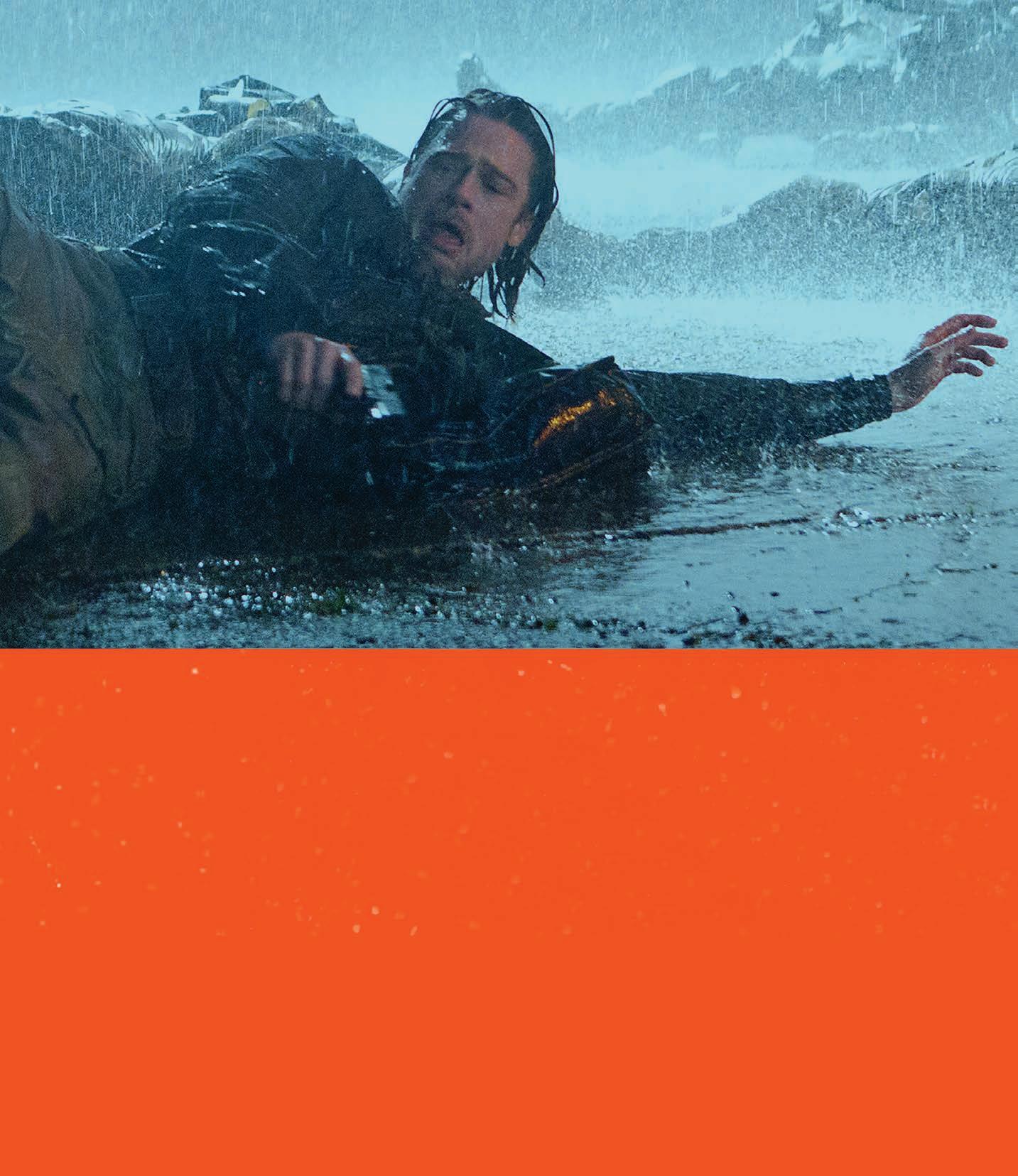
SON
I know zombies aren’t real. But they still freak me out.
Then, Father can only WINCE as he hears this.
SON (cont.)
Great parenting, Dad. Really freaking great.
END
SCENE
And that’s pretty much how I taught my children about movies — error and trial.
The son in that scene is now 25 and loves movies of all kinds. Like old dudes, he knows too much about “The Godfather” and “Pulp Fiction.” But, like sane people his age, his interests extend far beyond anything I showed him.
I take zero credit. He’s always been
moved by movies.
As a toddler he saw “The Incredibles” and then spent a solid 30 minutes sprinting on a sidewalk outside the theater, stopping only to tell strangers that, like Dash, he was invisible when he ran. As a slightly older kid, after a father/ son showing of “Barbarella,” he sprinted again, this time to his mother to tell her something he’d just learned:
Pop CornPop
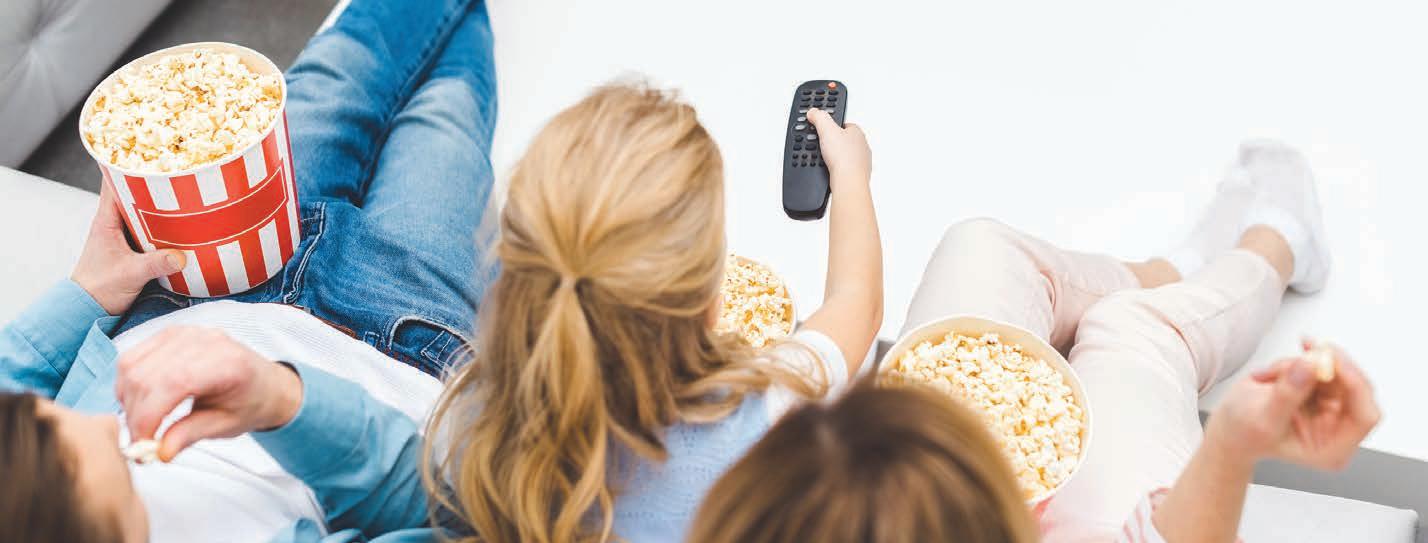
“Did you know Daddy thinks Jane Fonda looks good naked?”
In college, after watching “Okja,” a 2017 Korean movie about a smart pig and the cruelty of meat, he became vegan.
As a little kid he loved “Spirited Away,” the animated Japanese classic from 2001. Recently, he made me watch “Flow,” a Latvian movie that won the 2024 Academy Award for Best Animated Feature.
The movies aren’t really that similar. But he talked at length — something he rarely does — about how both movies made him feel. I learned stuff.
His sister, now 30, is less interested in film. She reads books. Also, I regret to admit, she may have learned movies the harder way.
Oldest kids always get a raw deal.
Our first movie together was “Men in Black.” The carpet was being washed, and we were marooned on a couch for a couple hours, and “Men in Black” was then fairly new to Blockbuster.
I was wildly entertained. Great film.
She was less enchanted.
“I was so scared,” she has said, repeatedly, over the years.
“It’s a comedy, not a documentary,” I have said, also repeatedly.
“I was 3!”
But my daughter and I
have shared other — I’d argue better — cinematic experiences.
We went to a theater to see “Happy Feet” when it was out, in 2006, and she was 11. I’ll admit now, publicly, that I may have dozed during the second (and the end of the first and most of the third) act. I’ll also admit now, publicly, that my opinion, expressed as we left the theater — that I agreed with the movie’s pro-environment message but found it to be “a little preachy” at the end — was ill-informed.
“Daddy, how much of it did you see? You snored so loud we couldn’t even hear the songs.”
Also, the entire “Planet of the Apes” franchise (except for the unfortunate 2001 Tim Burton effort) is a favorite of mine, as is “Sense and Sensibility,” and my daughter has watched exactly one of those with me.
Sometimes, however, our movie tastes merge.
A couple years ago, as she and a friend of hers were about to force me to watch an episode of “The Red Hot Bachelor” (or whatever it’s called), I proposed an alternative.
“What about ‘Constantine’?”
It’s a 2005 Keanu Reeves movie that’s kinda “John Wick” before “John Wick,” but with more demons and
roughly the same number of cigarettes. I figured at the very worst they’d like earlymiddle-aged Keanu.
My daughter and her friend were wary. My taste in movies was not on their usual playlist. But it’s my clicker and, technically, my TV, so we watched ‘C ”
They loved it. They didn’t admit it at first; it was late when the movie ended and they both harrumphed out of the room. But within a couple of days they both mentioned that ‘Constantine’ was pretty strong.
My daughter has even sought my suggestions for other movies. Sadly, about five years on, I’m roughly zero for 11,495 suggestions.
“You did recommend ‘Constantine’ that one time,” my daughter, an optimist, sometimes reminds me.
“Maybe you’ve seen another good one. Once.”
Which leads me to this: In theory, this story is supposed to explain how I taught my kids about movies. But that premise assumes two suppositions not in evidence.
Supposition One: I possess knowledge about movies worth sharing with children.
Over the years, I’ve tried and failed to write several movies. One of my log lines was “1966 Los Angeles, Roller Derby, and a love triangle involving two skaters and a team owner/
promoter.” (A couple producers actually nibbled at that one.) Another was “A troop of corrupt, promiscuous monkeys live to 300 and create a multilevel marketing scheme to become the world’s spiritual leaders.” A third was cleaner: “Dog spies!”
So, Supposition One is wrong. Whatever I know about movies is not worth sharing.
Supposition Two: My kids, or any kids, really, are willing to learn about movies from a parent. What movies did my parents love? No idea. The last movies they took me to see — a double feature of “Guns of Navarone” and “Zorba the Greek” — were in drive-ins when I was young enough to wear PJs and curl up in the back of the station wagon.
But that’s OK. I was never supposed to know what movies they like. Taste isn’t passed from one generation to another.
Passion is.
I love movies. Not as much as I love my kids, but a lot. And, over the years, I’ve made that point pretty clear.
Andre Mouchard is the assistant managing editor of The Orange County Register. He lives in Irvine with his wife, mother-in-law and the ghosts of several deeply loved pets.

ACTIVATE YOUR DIGITAL ACCESS
News moves quickly. As a reminder, Southern California News Group newspaper subscribers have unlimited access to all of our digital products. If you haven’t already activated your digital account, you can do so now and receive all the latest updates on your PC, laptop and mobile devices.
Go to scng.com/subscriber-services and select your publication to get started.
If you are not yet a subscriber, sign up now to receive complete coverage of the essential local news and information you need 24/7. To view your options, go to scng.com/subscribe



